“Balance of Terror”
Written by Paul Schneider
Directed by Vincent McEveety
Season 1, Episode 8
Production episode 6149-09
Original air date: December 15, 1966
Stardate: 1709.1
Captain’s log. In the ship’s chapel, Kirk is performing a wedding for two crewmembers, Angela Martine and Robert Tomlinson. Before the ceremony, Spock reports Outpost #2 along the Romulan Neutral Zone still is quiet, and now Outpost #3 has gone dark as well. The ceremony itself is interrupted by a distress call from Outpost #4, which is under attack by an unidentified vessel.
Spock briefs the crew on the Earth-Romulan War of more than a century ago, a brutal conflict between primitive spacecraft using atomic weapons. There was no ship-to-ship visual communication, so no one even knows what the Romulans look like. The war ended with a treaty, negotiated via subspace, establishing a Neutral Zone between the two governments’ territories, with outposts on asteroids monitoring. Kirk then adds that his orders are to avoid violating the treaty at all costs—to avoid war, the outposts and the Enterprise are considered expendable.
Lieutenant Stiles reveals that he had several ancestors who died in the previous war, and Kirk has to remind him that it was their war—not his.
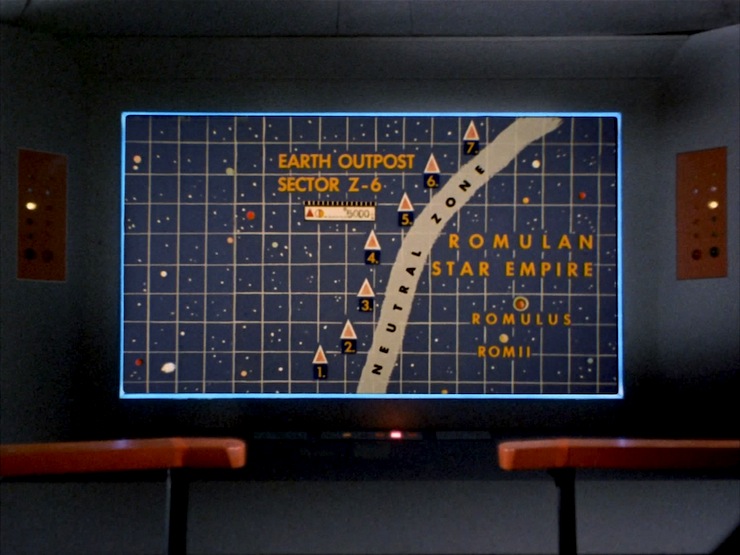
Spock reports that Outposts #2-3 have been destroyed, as have the asteroids they were constructed on. Kirk orders Uhura to send regular reports to Command and orders Sulu to call battle stations. Down in the phaser room, Martine assures Tomlinson that he doesn’t get off her hook that easily, and she fully intends to marry him.
The Enterprise approaches Outpost #4. Uhura raises Commander Hansen, whose command post is a fiery wreck, with deflectors gone—and it’s deep underground on an asteroid composed of iron. The enemy ship seems to appear and disappear. Hansen reports that not just #2 and #3 but also Outpost #8 are all destroyed.
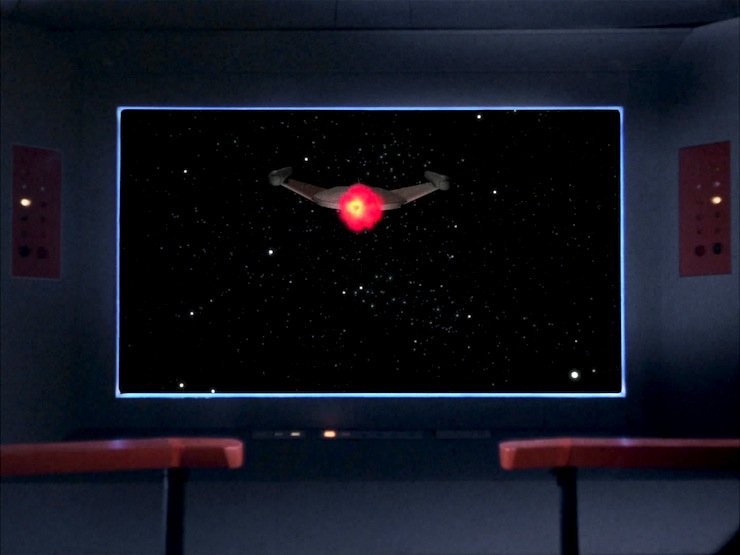
A ship appears suddenly, fires a high-energy plasma beam, demolishes the outpost, and disappears again—all while the Enterprise watches helplessly, still too far away to assist, and the ship is ignoring Uhura’s challenges and hails.
Spock can’t detect the enemy vessel—it only became visible when it fired the weapon—but he finds a blip on motion sensors that may or may not be it. The blip has changed course, and in a leisurely manner. The invisibility screen they’re using consumes tremendous power—probably why it needs to be dropped in order to fire—and that may also keep them from seeing the Enterprise.
The course the ship is taking is directly back to Romulus. Kirk orders Sulu and Stiles to follow a parallel course, to match the enemy ship move for move—make them think the Enterprise is a sensor ghost, a shadow. He also stands down from battle stations. Stiles—who is already whiny that they’re not on an intercept course—expresses a concern that there might be Romulan spies on the ship. Kirk is ready to dismiss the notion as paranoid fantasy until Sulu agrees and recommends they go to security alert. Only then does Kirk agree.
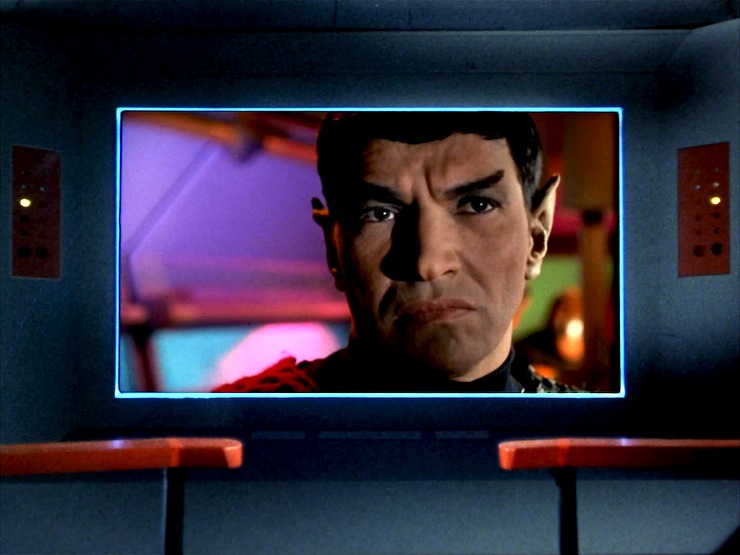
Uhura picks up coded communications from the ship, and Spock is able to lock onto them and get a picture of the enemy bridge.
The Romulan commander looks just like a Vulcan. Everyone is shocked, especially Stiles. When Uhura says that cryptography is working on the code they intercepted, Stiles mutters, “Give it to Spock,” at which point Kirk tears him about fifteen new assholes with regards to being a bigot on his bridge.
The ship becomes visible. Sulu maintains the parallel course.
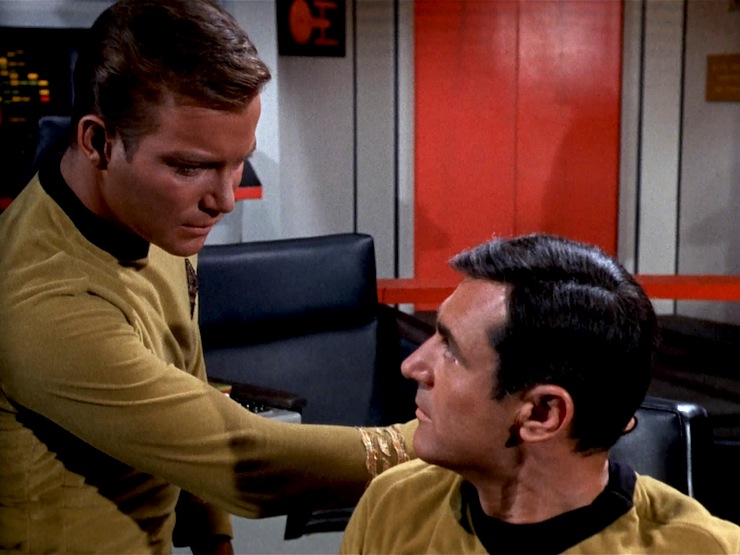
On the Romulan ship, their commander orders the cloak reactivated. He knows the outpost called a ship, and that ship could be what’s following them. His subordinates believe it is an echo—just as Kirk had hoped—but the commander isn’t so sure, and so the Romulan vessel becomes invisible again.
The commander then upbraids one of his people, Decius, who sent the coded message Uhura intercepted. Decius broke the rule of silence and is reduced two steps in rank. The commander’s centurion cautions that Decius has powerful friends, but the commander has no shits to give on that score. He’s tired of death and war, and sometimes even finds himself wishing for their destruction before they can return to Romulus and report back that their old enemy can’t stand up against their shiny new weapon.
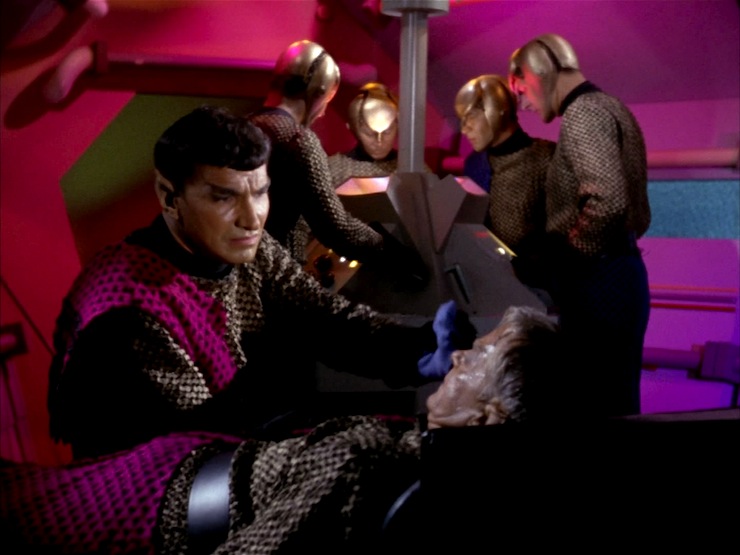
Kirk calls a meeting that includes Spock, Scotty, McCoy, Sulu, and Stiles. Spock shows a piece of Outpost #4’s debris that Scotty brought on board. The Romulan weapon turned a piece of rodinium, the hardest substance they know, into a substance as flimsy as tissue paper.
Stiles thinks they should attack, otherwise they’ll report back to Romulus that they saw the weapon and ran. Sulu points out the issues with firing on a target they can’t see, plus the report would be so much more awesome if they could say they also destroyed a starship.
Spock, amazingly, agrees with Stiles. Vulcan had an aggressive, savage colonizing period, and if the Romulans are an offshoot of that time, then they dare not show weakness. McCoy, for his part, thinks they’re insane to start a war that will cost millions of lives over theories about a people they know nothing about.
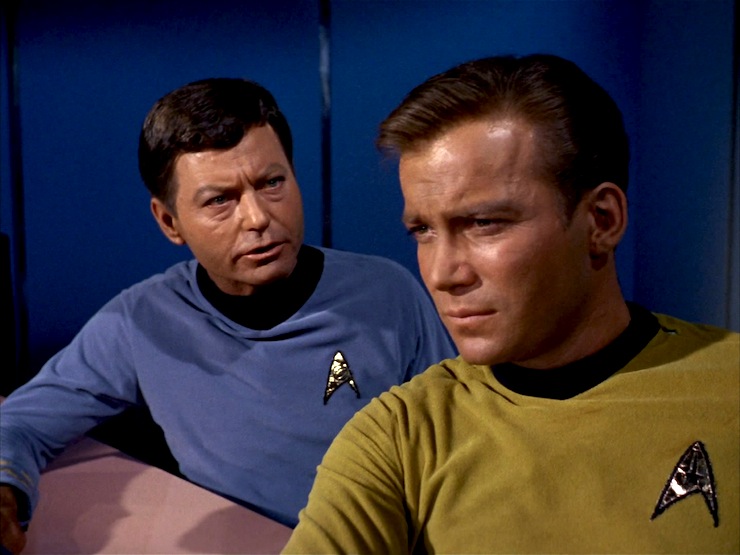
Checking the course ahead, Spock sees that the Romulan ship will go through a comet—which means it’ll be visible for a bit. Kirk’s plan is to do an end run and catch them as they enter the comet and become visible.
On the Romulan ship, we learn that the commander’s plan is to disappear within the comet and then turn around quickly and double back on the Enterprise. But when the sensor readings go clear when they enter the comet, the commander figures it out and calls for an evasive course.
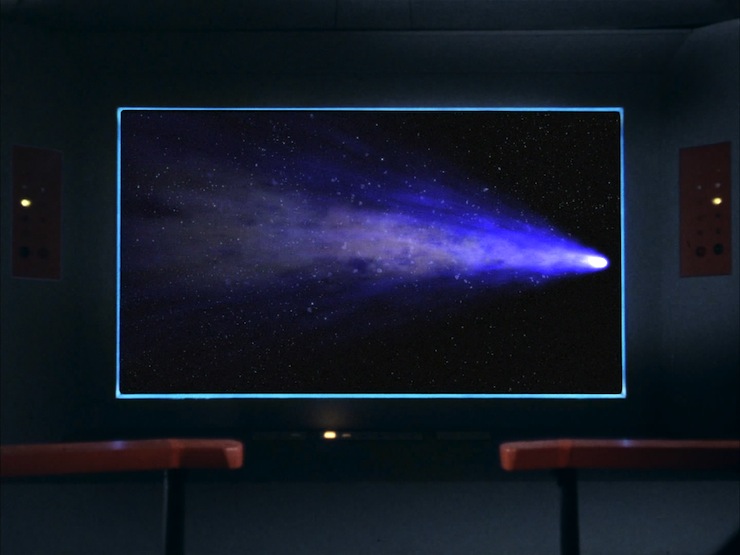
When Kirk realizes his trick didn’t work, he goes hard to starboard and orders Stiles to fire at random. They hit the Romulan ship, so he diverts all power to weapons and decloaks long enough to fire on the Enterprise. Unfortunately for Kirk, the phaser control circuit burned out, and Spock won’t be able to repair it before they’re hit by the plasma bolt. Sulu floors the accelerator, but the weapon is still overtaking them. However, the weapon starts to get diffuse, and Kirk realizes it has a limited range. It still does a bit of damage by the time it hits, but nothing like what it did to the outposts.
The Romulans are back on course for home, and Kirk orders Sulu and Stiles to ghost them again. When the Romulans report that their reflection is back, Decius thinks it’s impossible for the Enterprise to still be intact, but the commander is concerned enough to re-cloak, despite their low fuel reserves.
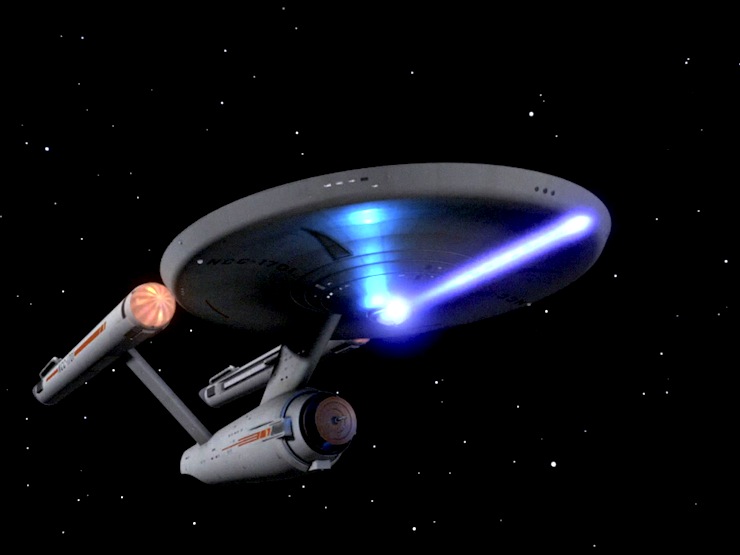
Once the Enterprise is one minute from the Zone, Kirk decides to go on the offensive. He fires on the Romulan ship while it’s still on their side of the Zone, and then follows them in, ordering Uhura to report to Command that he has no choice but to do so.
The commander refuses to decloak and waste energy firing the weapon again, especially since he isn’t sure it’ll work. He orders Decius to put all debris in the disposal tubes—as well as the body of the centurion, who was killed saving the commander’s life from falling debris during the Enterprise’s earlier attack at the comet.
Spock detects the debris, but reports that it has insufficient mass to be the ship. However, motion sensors have gone quiet, which means the Romulan ship hasn’t moved since dumping the debris. Kirk orders all power shut down, assuming (correctly) that the Romulans have done the same. For nine hours, both ships sit, playing possum.
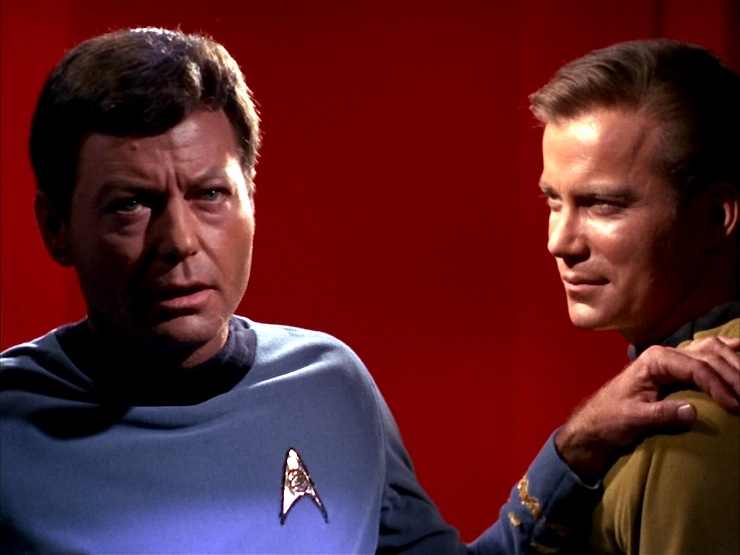
In his quarters, Kirk has a brief crisis of faith, wondering what happens if he’s wrong. McCoy bucks him up with a bit of existentialism.
While doing further repairs on the phaser circuit, Spock accidentally pushes a button, which creates a signal—the Romulans pick it up and move toward the Enterprise. Kirk immediately powers up and fires. The commander, frustrated, orders Decius to flush more debirs, this time with a nuclear warhead, used for self-destruct. The Enterprise doesn’t detect it until the last minute and detonates it with a phaser, but the damage is done. Lots of circuit burnouts, and lots of people with radiation burns. The forward phaser room is the only one available, and Tomlinson is staffing it alone. Stiles volunteers to help out, and Kirk sends him down, putting Uhura at navigation, and orders Spock to play dead, in the hopes of luring the Romulans back to their side of the Zone.
Decius insists that they move in for the kill, but the commander doesn’t trust Kirk. Still and all, he agrees to finish the Enterprise off.
Spock goes to the phaser room for a damage control report, and Stiles mouths off at him. After Spock leaves, Stiles notices a phaser coolant leak.
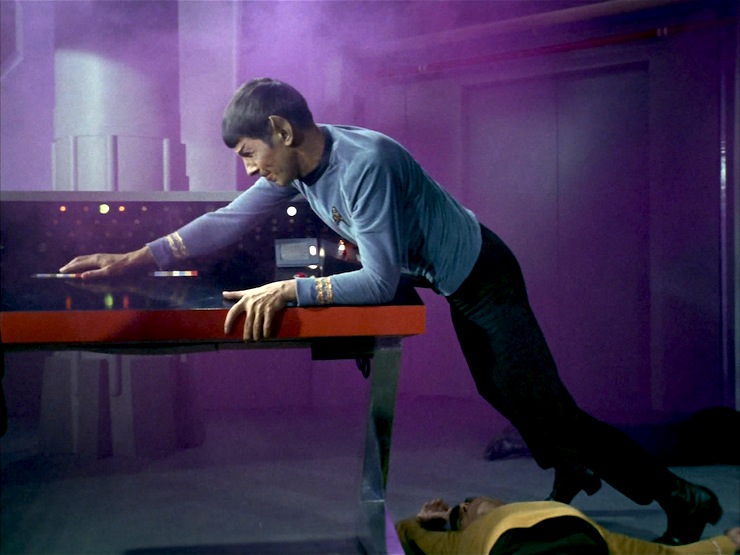
On the bridge, the Romulan ship becomes visible. Kirk orders phasers to fire—and nothing happens. When Spock hears Kirk bellow for Stiles to fire, he runs back to the phaser room to find Stiles and Tomlinson out cold on the floor, the room filled with coolant. Spock fires the phasers, which does horrendous damage to the Romulan ship, leaving it dead in space.
Uhura opens a channel to the Romulan ship, and Kirk and the commander share a bonding moment before the latter falls on his sword by destroying the ship. (How he did so without the warhead used for that purpose is left as an exercise for the viewer.)
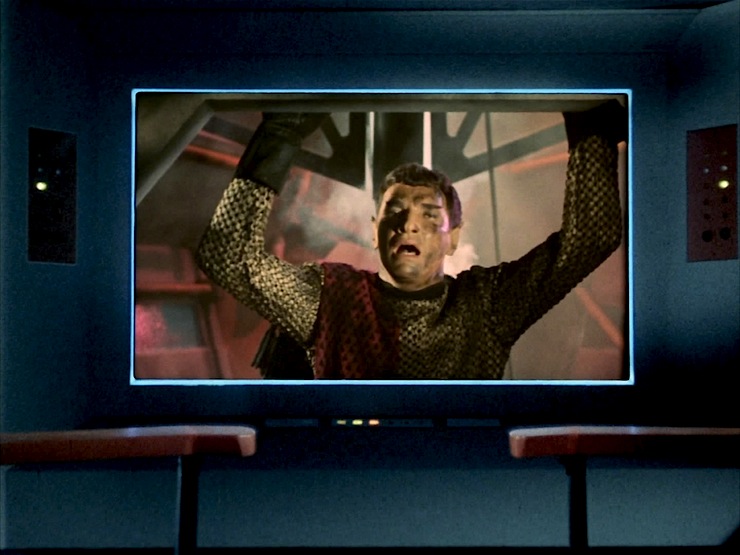
The only casualty was Tomlinson. Stiles would have died also, but Spock pulled him out in time to save his life. Stiles is rather baffled by this. Kirk goes to the chapel to comfort Martine.
Can’t we just reverse the polarity? Scotty says the Romulans’ power is “strictly impulse,” which mostly shows that Paul Schneider doesn’t understand interstellar distances, since faster-than-light travel is the only way the Romulan ship would get back home in a time frame that could be measured in anything less than decades.
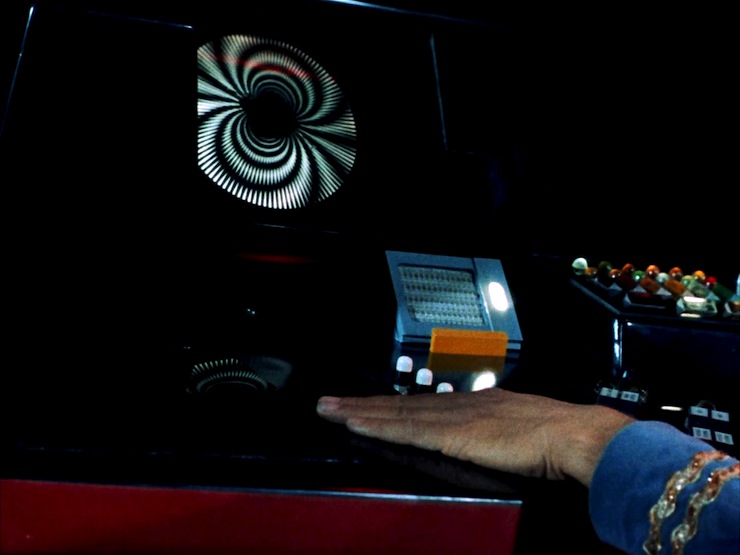
Also the phasers seem to fire like photon torpedoes (which hadn’t been conceived yet) and like torpedoes in submarines. This episode is the only time the firing of weapons on the ship is done by relaying commands from captain to navigator to phaser room—though there is a reference to “phaser crews” in “The Corbomite Maneuver.” After this, weapons are fired directly from the navigation console, either by the helmsman or navigator. (The notion of a separate tactical console won’t be seen until The Motion Picture.)
Fascinating. Spock is surprisingly quiet when Stiles treats him like crap—if nothing else, his line in the phaser room when he calls him “Vulcan” with disgust should get him written up, not to mention his attitude in the briefing room—and also reveals that Vulcans weren’t always rational, logical, peaceful types.
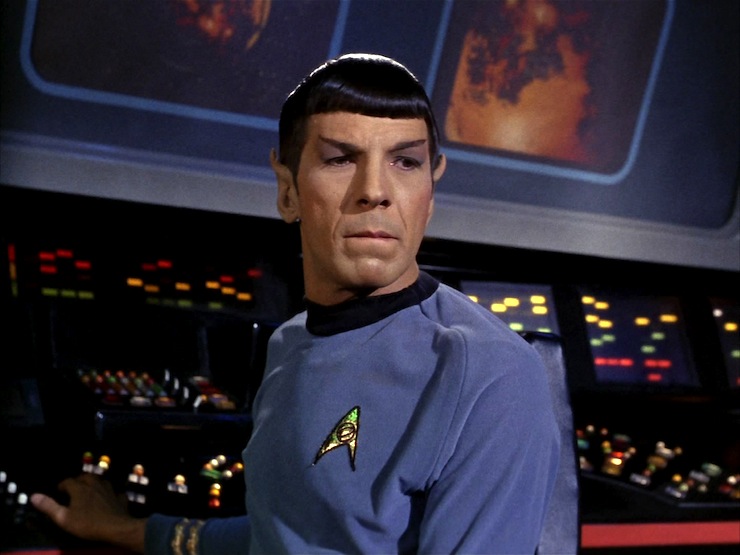
I’m a doctor not an escalator. McCoy’s trademark humanism is on display in the briefing room, as he’s against war at all costs, and he also gives Kirk a rather hokey speech about how there’s billions of planets in the universe, but only one Jim Kirk.
Ahead warp one, aye. Sulu saves Stiles’s ass by nominally agreeing with his racial profiling and suggesting security alert and then in the briefing room—probably because Stiles didn’t even thank him, the ungrateful bastard—argues against every point the navigator makes with regard to attacking the Romulans.
Hailing frequencies open. Interestingly, after Stiles makes his nasty suggestion that Spock decode the Romulan communiqué, Uhura goes ahead and makes a copy for him without being told to. She also gets to take over navigation again, but still has to open the damn hailing frequencies from there…
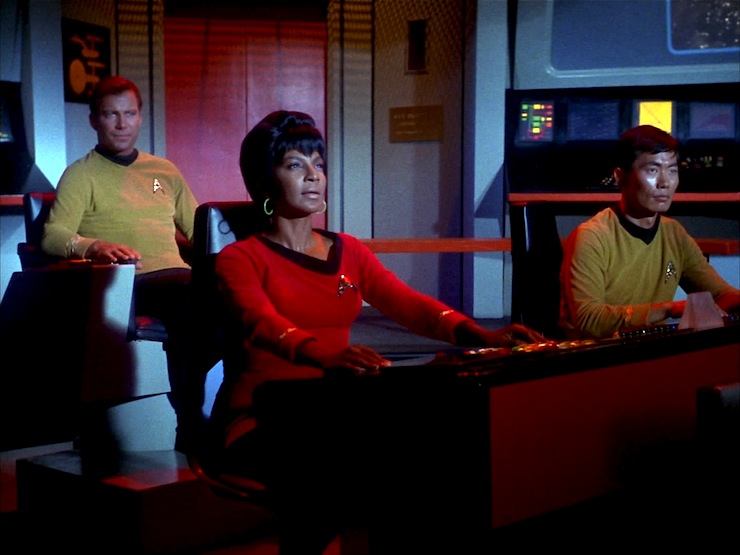
I cannot change the laws of physics! Scotty is apparently the ship’s videographer—he beams the abortive Tomlinson-Martine wedding to the whole ship.
Go put on a red shirt. Amazingly, the only Enterprise crew member who dies is Tomlinson. Poor Martine…
No sex, please, we’re Starfleet. Besides the we’re-almost-newlyweds banter between Tomlinson and Martine, we also have a totally gratuitous moment where Kirk clutches Rand to him when the Romulan weapon’s about to hit.
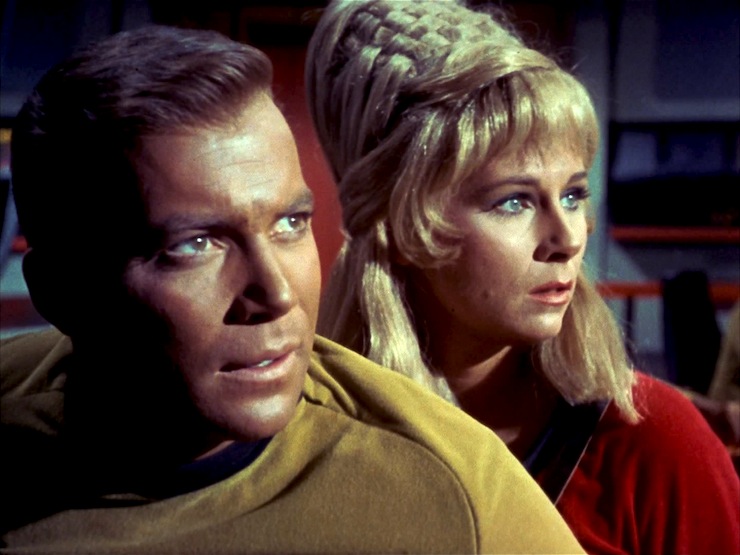
Channel open. “We are creatures of duty, Captain—I have lived my life by it. Just one more duty to perform.”
The Romulan commander’s last words.
Welcome aboard. Paul Comi is the latest member of the navigator derby as Stiles, while Stephen Mines and Barbara Baldavin play the ill-fated couple of Tomlinson and Martine. (Baldavin will return in the role in “Shore Leave”). Veteran character actor Garry Walberg plays Hansen, John Warburton plays the centurion, and Lawrence Montaigne plays Decius; Montaigne will return in “Amok Time” as Stonn.
Recurring regulars DeForest Kelley, James Doohan, George Takei, Nichelle Nichos, and Grace Lee Whitney are all here, too.
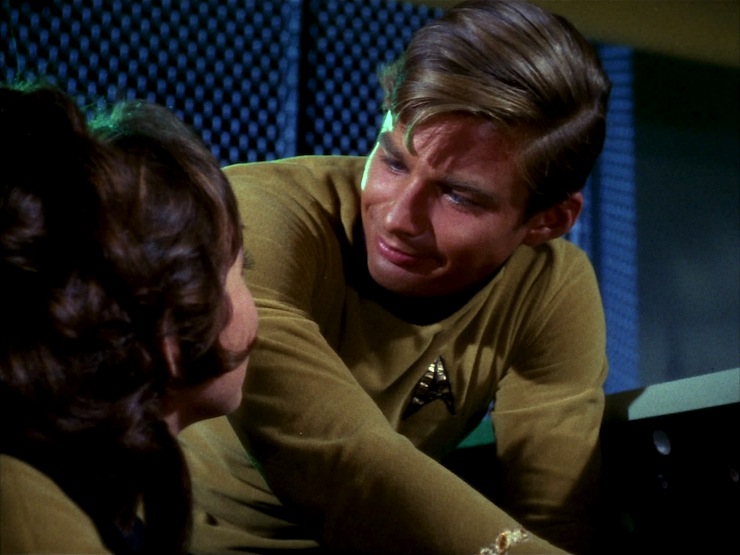
But of course the big guest is Mark Lenard as the commander. Lenard will be cast again in season two’s “Journey to Babel” as Spock’s father Sarek, which will become a recurring role on the animated series, The Next Generation, and several of the feature films. Lenard will also play a Klingon in The Motion Picture, making him the first person to play a Vulcan, a Romulan, and a Klingon.
Trivial matters: This episode introduces the Romulans, an enemy of the Federation that will continue to recur in this series, as well as all the spinoffs and a couple of the feature films.
This is the first of half a dozen episodes directed by Vincent McEveety, and the first of three written by Paul Schneider (the others being “The Squire of Gothos” and the animated episode “The Terratin Incident”).
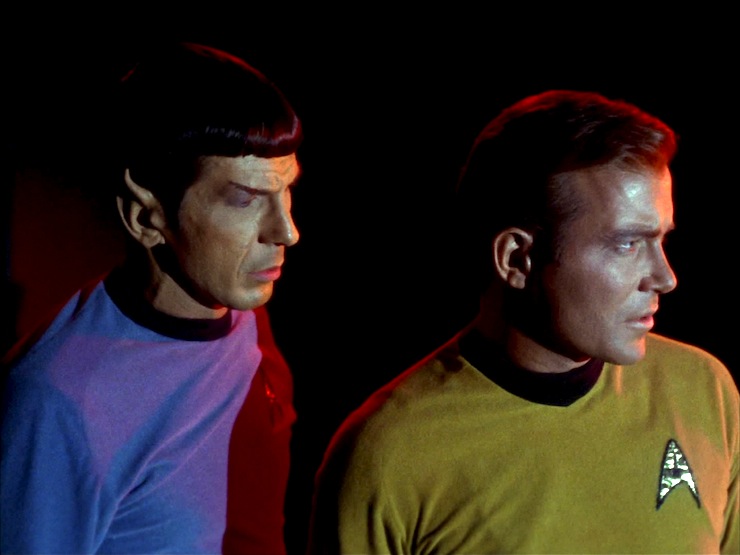
Schneider’s script was heavily inspired by two submarine films, The Enemy Below and Run Silent, Run Deep.
The Earth-Romulan War discussed by Spock in this episode was dramatized in the two-volume Romulan War novels by Michael A. Martin. Had the TV show Enterprise continued to a fifth season, it is likely that the show itself would have covered the war.
Because this episode established that this was the first sighting of Romulans by the Federation, the TV show Enterprise had to go through major contortions to feature the Romulans but not allow any of the main cast to see them.
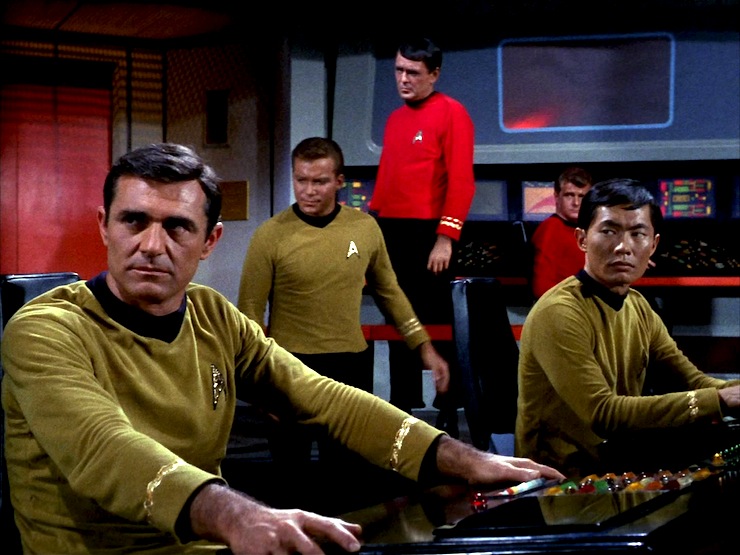
While Mark Lenard’s commander is never named onscreen, the Star Trek Collectible Card Game gave him the name Keras (an anagram of Lenard’s more famous role of Sarek). The comic book story “The Khitomer Conflict” written by Mike Johnson, issues #25-28 of IDW’s current ongoing Star Trek series that takes place in the alternate timeline of the JJ Abrams films, named him L’Nar.
The studio was considering both Lenard and Montaigne to possibly take over the role of Spock had contract negotiations between Leonard Nimoy and the studio broken down between seasons one and two.
Spock commented that Balok bore a resemblance to his father in “The Corbomite Maneuver,” yet he made no such comment about the Romulan commander, who is played by the same actor who would play his father. The Myriad Universes short novel A Less Perfect Union by William Leisner in Infinity’s Prism has the commander making use of that resemblance in an alternate timeline in which the Federation was never formed.
The commander also plays a large role (and remains unnamed) in John Byrne’s various comics featuring the Romulans for IDW, one of which, Alien Spotlight: Romulans, serves as the prequel to this episode. Byrne also adapted the episode in comic book form.
Stiles appears in several works of tie-in fiction, including Constitution by Michael Jan Friedman and the comic book Debt of Honor written by Chris Claremont. His first name has been given as John and Andrew. His ancestors who fought in the Earth-Romulan War are seen in Starfleet Year One by Friedman and the Romulan War duology by Martin. His descendent, Eric, appears in Red Sector by Diane Carey.
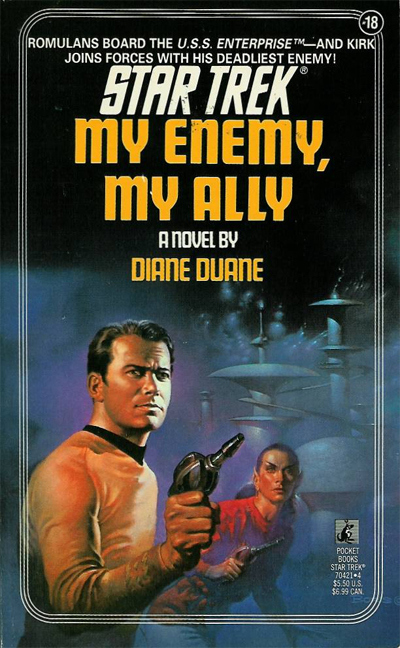
Several novels by Diane Duane—My Enemy, My Ally; The Romulan Way; Swordhunt; Honor Blade; and The Empty Chair—developed a detailed history and language for the Romulan people, including the name “Rihannsu” as the name the species has for itself.
The wedding ceremony Kirk performs will be seen again given by Picard when he married the O’Briens in TNG’s “Data’s Day” and by Ross when he married Sisko and Yates in DS9’s “Til Death Do Us Part.”
To boldly go. “He’s a sorcerer, that one, he reads the thoughts in my brain.” What an amazing thrill-ride of an episode. There’s tension, there’s action, there’s suspense—but all of that is secondary, because what makes this episode so particularly great is that it’s about people. Yes, there are stakes here, and yes the potential consequence of an interstellar war is a devastating one, but it works on an emotional level because throughout the entire episode, we see that it’s not about governments fighting or space ships firing on each other, it’s about people.
It’s about Martine, who’ll never get to marry the man she loves. It’s about Stiles, whose family history in the last war has made it impossible to look at the possibility of a new one rationally. It’s about Spock, subject to Stiles’s bigotry, as well as a revelation that affects his entire species. It’s about the Romulan commander, tired of war, but too much a creature of duty to do anything but follow orders. It’s about McCoy, unwilling to accept war as a given.
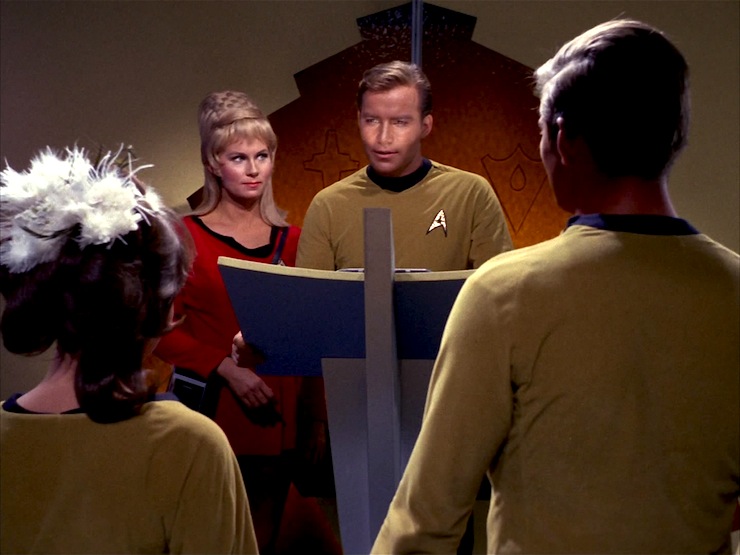
And most of all, it’s about Kirk, who holds the weight of history in his hands, as just a simple decision to move forward into the Neutral Zone is one that has overwhelming consequences, ones that could change the course of so many people’s lives.
So many great scenes here. The briefing room, with Sulu poking holes in Stiles’s gung-ho attitude, with McCoy doing the same for Spock’s insistence on war being an imperative. The interrupted wedding. The glances at Martine and Tomlinson throughout, making their tragedy at the end all the more poignant. The sidelong glances at Spock by everyone on the bridge after they see the Romulan bridge. Plus, every single scene on the Romulan ship, giving us a complex character in the commander and a wonderful glimpse at the politics of life in the Romulan Star Empire.
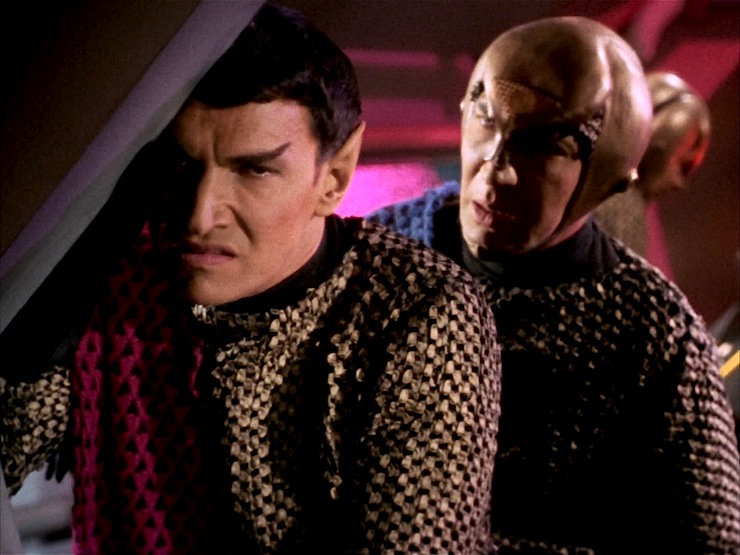
Mark Lenard gives a bravura performance here. His commander is a complex person, a smart one, a worthy adversary for Kirk—which in turn helps us look more strongly upon Kirk, who is elevated by his ability to keep up with him.
The episode isn’t perfect, for all that I can watch it a million times and be enthralled by it. Paul Schneider’s script doesn’t just wear its submarine-movie influences on its sleeve, it wears the whole damn shirt. Unfortunately, it’s at the expense of understanding how space works. As Douglas Adams reminded us, space is big—really big. There’s just no way in the huge-ass vastness of space that being visible really matters all that much. Sensors—portrayed in every other Star Trek story ever as being super-efficient methods of detecting things—are shown here to be less reliable than sight, which makes them useless in space. Everything is too far away from everything else for sight to really matter all that much, so the fact that they can “only” target with sensors is a feature, not a bug.
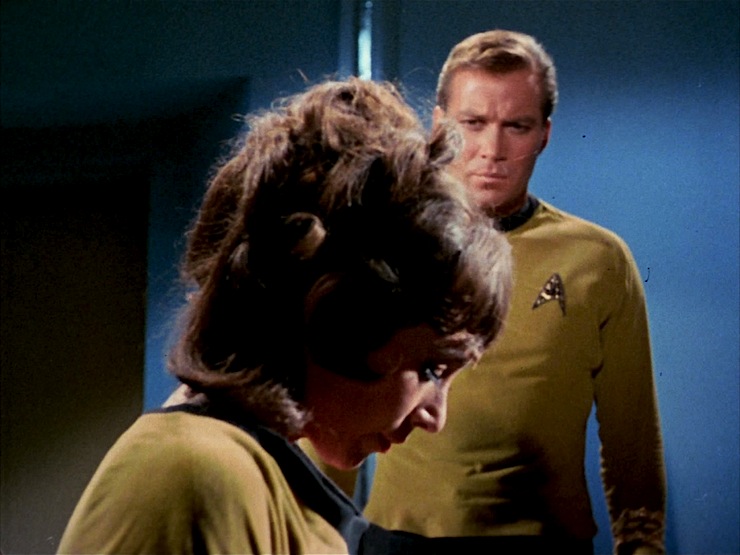
But that’s a minor nit in what is otherwise a brilliant episode, one of Trek’s finest that also gave us the franchise’s longest-running antagonists in the Romulans.
Warp factor rating: 9
Next week: “What Are Little Girls Made Of?”
Keith R.A. DeCandido’s latest story is “Down to the Waterline,” a story featuring Cassie Zukav, weirdness magnet, and taking place in Key West, Florida. It involves nixies, scuba diving, rock and roll, the ghost of a wrecker captain, and the evils of spam filters. It’s available for free on Buzzy Mag online.










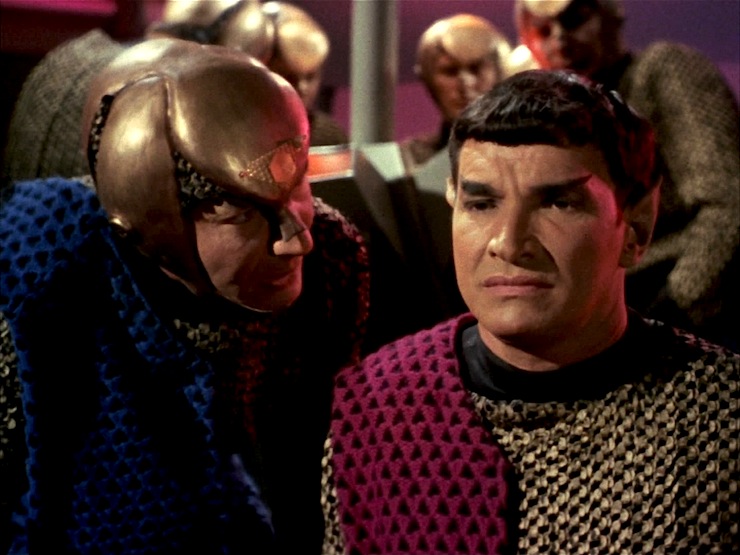
You forgot the likeliness of being able to hit an invisible target in space by firing at random even if the distance has been closed to ‘somewhere in a comet’.
Just rewatched this last week, the new SFX were very CGI but just as enjoyable as the old. I think that Star Trek was pretty incredible for touching on social issues and being very entertaining.
I was Very confused at the end of this episode, that phaser room coolant leak seemed Way too coincidental. I did not believe that it was an accident, and there seemed amazingly little investigation into it.
I rewound the sickbay scene several times thinking that I missed some dialogue confirming that it was an accident.
Don’t you think McCoy or Spock should have had a line that acknowledges a fault or damage to in the system?
I found this to be the weakest part of the episode, especially with the dialogue between Kirk and the bride at the end.
Thank you for writing About the original episodes, I look forward to more.
This is one I like more every time I see it. I actually appreciate McCoy’s “hokey” speech to Kirk, but maybe more for it being in the context of the scene as a whole, which really calls back to the Pike-Boyce relationship from “The Cage.” It’s a fine statement of the worth of the individual, as well as being some sound medical and psychological advice (don’t kill yourself with stress), and it’s another great indication of the friendship between these two men.
I also like — in a sad way — the beat near the end, when Rand reports that Starfleet has finally and very belatedly given Kirk the go-ahead to handle the situation as he sees fit. It’s a clear preseravtion of the original concept that the Enterprise was truly out on the “final frontier,” far from civilization and not able to call back to HQ for help in a timely way. For all intents and purposes, they’re on their own. This aspect of the premise would erode rather quckly, as I recall.
And when we will see such well-developed guest crew again? Stiles is a bigot, but comes off as more than a bigoted jerk because of the family history he reveals. (Love Kirk’s verbal slapdown of him, all the same.) Martine and Tomlinson aren’t on screen together much, but as the screencap you chose shows, they’re clearly very much in love. And Spock is “strangely silent” because Stiles’ words sting so much (coupled, I expect, with the first ever look at a Romulan – that’s a lot to take in at one moment). And, as you point out, great stuff from Mark Lenard, especially in his scenes with the older centurion.
I’ve always wondered what’s going on in that bit of stage business where Kirk offers Spock a book and Spock pushes it back down to the table. Is it the treaty, and Spock is so familiar with it he doesn’t need or want to look at it right then?
“Balance of Terror” is one of the best episodes of Star Trek, movies included. It is certainly in the running for best episode, period.
It’s got it all, fine acting, good writing, suspense, action, pathos. The decision to base this episode on submarine movies is inspired. Not only does it make science fiction accessable to new viewers, by way of nostalgia, it provides an excellent point of reference to real life experiences of the audience (WWII vets). Wedded to this is the careful examination of bigotry and racism. It hooks viewers with it’s suspense and action, provides an entrypoint into science fiction as a genre and examines contemporary social issues.
“Balance of Terror” is not just superb as Star Trek, but as science fiction. Few episodes of any Trek series come as close to what science fiction is supposed to be and what it can do.
I always found Diane Duanes Romulans much more intresting than how they were portrayed in STNG. I have no feelings on Romulans in NU-TREK other than they blew up Vulcan and are insane. I always thought it was gratuitus that Tomlinson was the only one that died in a section of the ship never mentioned again.
Wrath of Khan also has great success ripping off submarine movies.
I think Balance of Terror was really on to a fundamental rule of good writing: if you want your fictional battles to be exciting, make them asymmetrical. If your space battleship is fighting their space battleship, you just have big guns blasting away at each other until someone blows up. Space destroyer Vs space submarine gives you many more options for writing a scene. The Battlestar Galactica remake used this well. Galactica and Vipers were at a disadvantage to jump capable Raiders, unless they could close the range and have the tough Galactica directly engage the fragile baseships.
I’m quite sure that Jutland was exciting to be at, but Taffy 3 is way more interesting to read about.
An excellent write-up for an excellent, memorable and enduring episode! I’d only add that I think you can insert the Vanguard books, especially book 2 onwards, as they deal with the lead up to this episode and from book 4 the consequences outwith the series of the Romulans’ return to the stellar-political scene.
I’d agree with @5, the TNG romulans could be so dismal – crypto-Vulcans. So lacking in promise, or culture, or interest – compared to the Romulans in TOS or even the Romulan ambassador in The Undiscovered Country (or, I guess, the Final Frontier).
I have always felt that BoT is really one of the best, if not the best, episode of the original run.
My favorite little scene is at the very, very end as the credits begin to roll: a very human James T. Kirk visits Martine. As he leaves the chapel, he is vulnerable, shoulders slightly slouched. As he walks away, among his crew, he becomes the leader again. The Captain. The shoulders go back, and he walks with purpose. Shatner plays that perfectly.
Again, just here to say this was a good episode, really strong (and as noted, very memorable) performances by everyone. I’m not sure I would give it a 9, especially in a re-watch. As noted, it had more fridge logic moments and that pulled me out of it, to much of the submarine battle feel, plus I’ve never been a fan of battles, war maneuvers, etc. type stories. What I do remember (and again, this was an episode that I saw well after it times, unlike others that I saw closer to the 70s), was how progressive and balanced it seems, and not-with-standing that Uhura still had to open hailing away from her nominal station, that it showed a far more balanced situation than other shows playing at that point in time (and even well after wards).
A terrific episode on all accounts. Made all the better by the presence of Stiles. A bigot who inspires the remainder of the crew to rise above their shortcomings. Tense, well characterized, with a terrific antagonist in Mark Lenard.
It’s this episode that makes me wish Enterprise had gotten a fifth season, so Manny Coto could have dealt with all this backstory.
The only thing that really bugs me is the rather convenient coolant leak in the phaser room. I don’t recall if the prior nuclear blast that damaged the ship had anything to do with the leak, because it feels rather conveniently staged for Spock to jump in and save the day.
As for the submarine angle, I understand why Schneider and McEveety embraced the concept so thoroughly (even though having phaser rooms makes no sense; imagine trying to coordinate them in a shootout against the Borg and the need to remodulate phaser frequencies).
I also understand why Schneider would make the mistake with Romulans travelling on impulse. I cannot understand however that Bob Justman and Roddenberry failed to notice that blatant error. According to Star Trek Memories, one of Justman’s roles as Associate Producer is to evaluate first drafts of scripts to make sure they’re ready for production. He’d notice the impulse power line.
8. Having read Castles of Steel, I’m not so sure. Until I read that book, I would not have thought it possible for so many battles to start with each side ambushing the other. It’s like one Koom Valley after another.
It’s a fine example of what science fiction should be. If the fiction is good, the science really doesn’t matter. (another example is Han Solo’s use of the word “parsecs”). Unless you’re billed as hard sci-fi, which Trek abandoned straight out of the gate, starships and advanced technology really should just be set dressing. In this episode, that’s exactly what we get.
On the flipside, if the fiction is bad, the science really won’t save it.
One interesting detail I learned recently:
The original script apparently had Commander Hansen speculate that the attacking ship was built from a stolen Federation design, which added fuel to the fire of Stiles’s accusations against Spock- and which clearly influendced the design of the model. It also would have put the use of a Klingon ship design later in a different light.
Interestingly, Star Trek III originally called for Romulans to be the foes, but the studio felt Klingons were more accessible to the movie-going audience. Hence, a ship designed for Romulans became one of the Klingons’ iconic designs.
@5 I wondered that myself. It’s a strange bit of stage direction that doesn’t seem to have any purpose. I wonder if it related to a deleted scene or something cut out of the script prior to filming. If none of those, your theory is as good as any, I think.
In fairness, Scotty doesn’t say the Romulans’ power is “strictly impulse,” but “simple impulse.” Which probably meant that they only had impulse drive and not warp, but I prefer to take it to mean that they had only a simple, basic form of impulse drive while the Enterprise had a more complex, advanced form that would let them outmaneuver the Romulans at impulse. (He also said “their power,” not “their propulsion,” so he might not have been talking about the drive systems at all.) Of course, Enterprise verified once and for all that the Romulans did have warp drive in the 22nd century.
The second-season writers’ bible for Star Trek specifically called out Kirk’s clinch with Rand on the bridge as an example of unrealistic, unprofessional behavior that writers for the show should take care to avoid. So clearly the producers were kind of embarrassed by the fact that they let that through.
And Byrne’s comics do not use the name Keras from the card game; they carefully leave the Commander nameless (just as Byrne also does with Number One from “The Cage”). Memory Beta’s entry gives the impression that the name Keras was used in the Byrne comics, but that’s just because MB’s editors like to blend info from different sources in a single entry, which can make it confusing to determine what comes from where.
I agree with Keith about the episode — great character work, problematic physics. First off, invisibility is dead simple in space — just turn off your lights! It is, after all, pretty dang dark out there. As long as you’re not emitting light or firing your engines or broadcasting radio signals or passing close enough to a star to reflect its light, you’re gonna be pretty hard to spot.
Second, hiding all your emissions is pretty much physically impossible. Any spaceship generates heat, and sooner or later it’s going to have to radiate that heat out into space, or else the crew will cook. Even if there were some way to contain all your ship’s heat and emission and prevent them from radiating out into space, it could only be done for a short time before you had to turn off the field and let the ship cool down. (I think this is actually part of the combat dynamics in Mass Effect, IIRC.) Here’s a good article on the problems with stealth in space.
There’s also the Enterprise‘s “motion sensors,” which are the equivalent of sonar in a submarine movie, letting you sense the motion of what you can’t see. Okay, how do you sense motion in space? Pretty much 100 percent of the time, by seeing something move. Okay, sometimes it’s by seeing something else move, e.g. detecting a wobble in a star that lets you deduce that it has a planet affecting it gravitationally. But a starship in deep space isn’t going to have that much of a gravitational influence on anything except space dust. Maybe you could detect its wake in the interstellar medium, or the blueshifted photons that bounce off it as it moves at relativistic speeds, so yeah, it might not be completely out of the question if your sensors are keen enough. But then, why is it only possible in this episode? We never hear about motion sensors again.
Another part that works in submarine movies but not in space is the proximity detonations. Despite what almost every sci-fi episode and movie has ever shown, being close to an explosion in space has very little effect, since there’s no medium to propagate the blast effects. At most, the thermal shock from a nuclear or antimatter explosion nearby might be enough to vaporize the surface layer of material on your hull, which would be kind of like being hit by an explosive. But those phasers would have to be coincidentally coming within a few kilometers of the ship out of gajillons of cubic kilometers of space. That one always bugged me about the episode.
Musically, Fred Steiner provides a partial original score here, debuting a theme for the Romulans which he would later recycle and develop further as the Mirror Universe theme in “Mirror, Mirror” (and use a variation on it as Marlena’s theme in that episode), and which George Duning would subsequently borrow as Henoch’s leitmotif in “Return to Tomorrow.” Ironically, it was never again used as a Romulan theme, since “The Deadly Years” mostly used stock music from “The Doomsday Machine,” and “The Enterprise Incident” featured new Romulan motifs by Alexander Courage (although his theme for the female Commander sounds like it’s influenced by Steiner’s Romulan motif).
@3/MikePoteet: The book is a Table of Comets for that particular sector. Kirk hands it to Spock when he asks about the composition of the comet, presumably thinking that Spock will need to look it up, but Spock is so awesome that he has the composition of every comet in the sector memorized already. It’s an odd bit of business, given that the ship has a computer and all, but it was an early episode, after all.
Schneider’s script was heavily inspired by two submarine films, The Enemy Below and Run Silent, Run Deep.
Yes, this is basically the story of a surface ship trying to find and destroy a submarine, but IN SPACE. Never forget the TvTrope, Space is an ocean.
The answer to your question KRAD, if how the Romulan ship self destructed after firing the warhead? Simple, they had more than one. The commander asked if they had some of the old style nuclear warheads aboard and then said to place one in with the debris. Just the way the commander’s statement is made, gives indications of there being more than one.
@10/Eduardo: Actually a lot of TOS episodes are vague on the concept of interstellar travel without warp drive. The Enterprise in “Where No Man Has Gone Before” is able to limp to the Delta Vega system at impulse. Ditto with “Mudd’s Women” when it limps part of the way to Rigel XII on impulse. It was also unclear whether TOS shuttlecraft had warp drive, but they were able to make interstellar journeys in various episodes. So it’s not something the producers were always vigilant about.
Isn’t there an episode where Scotty is wowed by a ship’s ion propulsion, almost like it’s superior to warp drive? I may be misremembering it, but anyway he seemed mighty impressed by this ship for some odd reason.
Balance of Terror was the first episode of the original series I saw, on VHS in the early 90s. A good starter. And really overall an excellent work of television.
An excellent episode, one of the best of Star Trek, despite the science and continuity glitches.
Star Trek: Enterprise (oh, how I hated that name) could’ve coverd this in S5, if their first two seasons hadn’t been total crap. S3 was only not very good. S4 was improving, but there you go.
AdamO @2- Battle damage should be the obvious cause of ship’s system faults here.
Jose Tyler @8- I keep saying, Shatner can act!
Montaigne, though- I wasn’t impressed by him here, nor in Amok Time. Did he know someone on Trek’s staff?
ETA: George Kaplan @18- You seem to be thinking of Spock’s Brain.
Spock’s Brain? Oh yeah, and now I’m going to try to forget it again! Ha ha.
@19/sps49: I think that Lawrence Montaigne got cast in this and “Amok Time” on the strength of his resemblance to Leonard Nimoy. As Keith said, he was one of the candidates to replace Nimoy as Spock (or some equivalent Vulcan) if contract negotiations didn’t work out.
I have read that this is the only time in TV shows or movies when the Enterprise was shown to have a chapel. Is that true, O ye wizards of ST lore? Do other weddings, funerals, etc. just take place in generic assembly venues? Roddenberry didn’t want the Enterprise to have a chapel, so I do wonder how this got by him.
@16 leander good call on their being more than one nuke on the Romulan ship–I recall the commander telling the centurian (or was it Decius?) that “we have several” of the old-style nukes on board. They used one as a depth charge, and used the rest for self-barbecuing.
The comment about the Romulan ship only having “simple impulse” can easily be ret-conned thanks to Timescape—knowing, as we learned in that episode, that Romulans use quantum singularities, and not matter/antimatter-mediated-by-dilithium reactors, we can infer that the Enterprise crew was looking for engines similar to their own, didn’t find any, and for whatever reason didn’t recognize that there was a singularity powering the ship!
Interesting trivia–the fake Romulan ship that rendezvoused with the fake Enterprise on Barash’s holodeck in Future Imperfect is named “Decius,” as KRAD mentioned in the write-up for that episode!
@17: To be fair to WNMHGB, Delta Vega was specifically mentioned as only being a few light-days away, which wouldn’t be unreasonable at the sort of speeds impulse is supposed to achieve. The weirdness is that Delta Vega is so close to the edge of the galaxy in the first place, not really the fact that they were able to reach it at impulse.
I always wondered about the phasers in this episode. Now that I know it was an early episode and that photon torpedoes hadn’t been imagined, I understand !
Saavik: the chapel was seen again in “The Tholian Web,” used for Kirk’s memorial service.
—Keith R.A. DeCandido
@12/lerris: but the studio felt Klingons were more accessible to the movie-going audience – Yeah, I never quite understand why Klingons became “The Star Trek baddies” since they really only appeared in a handful of episodes. I guess it’s because Colicos, Campbell and Ansara were so damn good in the roles, the species made an indelible impression thanks to them. Still, it’s not as though the canonical information on Romulans was so vast in 1984 that a general audience couldn’t have grasped, “Ok, so these guys are like a space Roman Empire at war with the good guys.” Oh, well. Had the ST III Romulans not turned into Klingons, we wouldn’t have gotten (a) Christopher Lloyd’s magnificent Commander Kurge, or, quite likely, (b) the richly developed Klingon culture we have today.
@14/Christopher: Thanks! I never knew that. How funny. It is a little anachronistic, as you point out; but, hey, maybe Starfleet wasn’t quite finished transitioning from the dot matrix printer of “The Cage” <g>.
For those who, like myself, loved this episode, you might want to take a look at Glen Cook’s novel, “Passage at Arms” which is also a submarine vs. destroyer in space story. Interestingly, it raises the very issue identified by Mr. Bennett above. The sub can stay “submerged” in a kind of undetectable subspace, but must eventually “surface” to vent heat. As for the phasers in this episode, I always sort of liked the burst fire effect- it sort of had more of a big ship volly fire feel. Didn’t the Defiant also fire in bursts?
I’ve always liked the way the Romulan commander mirrors Kirk. The centurian is his Spock. Decias is his Stiles, but one protected by influential friends and family and the product of a world where his views are the approved ones.
I do wonder about Stiles. His anger is a lot more like a man who lost family he knew in the war, not strangers from a century back. His attitude towards Spock suggests he has some reason to suspect a connection between Vulcans and Romulans. It’s certainly possible that the Vulcans began to have suspicions that they didn’t want to share. It’s also possible Earth’s leaders had some evidence they didn’t want to make public. Why risk blowing up relations with one of your top allies for something that may be completely wrong?
But, a frontline soldier (which I’m assuming Stiles relatives were) might have come across evidence that was ignored by higher ups or that they were told to forget. The relative told family, though, and it helped fuel Stiles sense of grievance (I assume Stiles was a good officer until the massacre and knowing they were dealing with Romulans, something that set him off).
And Uhura proves she can do someone else’s job but she’s still the only one who can open hailing frequencies. That communication equipment must be more difficult than we realize.
Great episode, always loved it.
@28 – Oldfan: Yes, IIRC, the Defiant has “pulse phaser cannons” that have that effect, and according to a videogame, they build up phaser energy inside a magnetic field so they can achieve a higher rate of “phaseriness” (my word), then release it in a pulse, not a continuous ray, thus doing more damage, but with slightly shorter range than traditional phaser beams.
One of the things that I like about this episode is the things we don’t see.
The Romulan Commander, for instance, is tired of war. He wants to go home, etc.
Since the Fed-Rom War has been over for a century, its clear that the Romulan Commander has been at war – with someone else – long enough that he’s tired and only his duty sustains him.
So who have the Romulans been at war with so long after the Fed war?
@17: The Motion Picture somewhat addressed that issue, by establishing a difference between using thrusters and impulse power.
When they left Earth, Sulu was ordered to move the ship at Warp .5, which drove them past Jupiter in less than a minute. Essentially, it was half of Warp 1, and you’re not at Warp Speed until you reach Warp 1. I assume that’s full impulse power, while they chose to use thrusters while leaving spacedock.
So who have the Romulans been at war with so long after the Fed war?
@31: A wild guess: the Cardassians?
They have an Empire, which, while we never see other races on screen until the Remans, assumes they actually have conquered and dominate other species or civilizations. So they’ve been hard at conquest at their corner of the galaxy.
Impulse drive has been confirmed to work similarly to warp drive but on a smaller scale. The impulse drive is driven by fusion power and usually limited to sublight speeds but can do as much as Warp 2 or so if pushed hard. The impulse coils generate a distortion field which “shifts” the ship’s mass into subspace, thus eliminating much if not all of it’s inertia (and thereby also form the base of the inertial dampening system) and allowing it to attain very high velocities without incurring relativistic effects. It also directly generates momentum without use of a thrusting medium. The warp field generated by the main engines is the same basic thing, just much stronger and shaped to create a bubble around the ship. That bubble is shaped to propel the ship faster than the impulse drive alone can do, I forget the specifics but it is something to do with the shape interacting with spacetime in such a way that it produces motion.
The shuttles use this drive to achieve low FTL velocities, and presumably early starships did the same. That may be the case with the Romulan ship here, and in fact it may be that they are limited to that drive because of the need to stay cloaked. It’s stated that the cloak uses a lot of power, maybe it limits them to the lower power impulse drive while in use. Once they were clear and able to drop cloak, they could well have been able to engage warp drive and make the rest of the journey much quicker.
So, a starship in Trek is nothing like a rocket or other vehicle with conventional propulsion, even it’s low power drive is a mild FTL drive. Interesting stuff.
Another great write up KRAD. Thanks. I was waiting fr this one as it’s my all time fave ST ep. As you say the human side of the characters is what carries it and the way the larger issues weigh on them.
The random firing of phasers in big ol’ space: As you say, the episode was essentially the rewrite of a WW2 story about a sub hunt. This led to a whole lot of things being squeezed in that later on, after watching it about 15 times or so, leave you thinking “huh?” In particular: The phasers sure seem to behave a lot like depth charges here don’t they? Not only can they do damage against a sheilded target by proximity, but they seem to explode when they reach their range. Pretty amazing tech that — being able to program a beam of energy to explode after going a specific distance through space. Still…so many other things with this one were excellent so it’s easy to grit your teeth at the small handful of oddities.
MikePoteet: The Klingons appeared in six episodes of the live-action series — “Errand of Mercy,” “Friday’s Child,” “The Trouble with Tribbles,” “A Private Little War,” “Day of the Dove,” and “The Savage Curtain” — one of which is arguably the most popular episode of the series. The Romulans only actually appeared in two: this one and “The Enterprise Incident.” Plus, the Klingons were seen in The Motion Picture (with their shiny new foreheads). The more-recognizable argument in 1984 is a good one….
—Keith R.A. DeCandido
@36: There’s also a Klingon in “Elaan of Troyius” (on screen).
“Balance of Terror” is definitely one of the best episodes. When I watched it for the first time, I was surprised how good it was. I had heard about “The City on the Edge of Forever” and “Mirror, Mirror”, but never this one.
Martine and Tomlinson were so young and so sweet, that made it so much worse when he died.
@25/Danis (and, well anyone else who’s interested): I think that another reason the phaser effects are different here is that this was the first episode to have its effects done by Film Effects of Hollywood. Well, possibly the second, since they also did “The Menagerie,” which was aired before this one, but the first in which ship’s phasers were used. So their FX artists may not have been up to speed on how their predecessors had done the phaser effect. At least, that’s what I’ve always figured.
@27/MikePoteet: As Keith and Jana mentioned, the Klingons were in seven TOS episodes, far more than any other aliens other than Spock. The Romulans were only in three episodes if you count “The Deadly Years,” and that was just their ships. By ’60s standards, recurring seven times in three years was a lot. For comparison, The Wild Wild West‘s primary recurring villain, Dr. Miguelito Loveless (played by Michael Dunn, whom we’ll see in “Plato’s Stepchildren”), appeared only ten times in four seasons and 104 episodes. That’s a bit under 1 in 10 episodes, which is comparable to the Klingons’ record on TOS.
And the problem with presenting the Romulans to movie audiences in TSFS wasn’t just that they were not well-known, but probably also they looked like Vulcans, so it’d be confusing. Although TFF and TUC managed to pull it off.
@32/Eduardo: There’s no evidence that the Enterprise in TMP got to Jupiter in less than a minute. Sure, the way the music and the images are cut together imply that the Jupiter flyby was at the end of the preceding scene, but it’s actually at the start of the next scene, under Kirk’s log entry, so there’s some elapsed time in there.
@34/Han Rasmussen: Interesting, but it’s worth noting that all that stuff about low-level distortion fields was a TNG Technical Manual retcon. The simple fact is, “impulse engine” is a roundabout way of saying “rocket.” It means an engine that works by impulse, i.e. by thrust. The TOS writers’ bible makes it quite explicit. From p. 8 of the 1967 edition: “The Enterprise has a secondary propulsion system. These are impulse power engines (same principle as rocket power), located at the rear of the ‘saucer section’. Vessel speed, when using the impulse engines is, of course, less than the speed of light.” So at the time TOS was made, there was no intention of impulse drives having any kind of FTL capability. Some of the writers just got it wrong, and later fans and creators have tried to rationalize the goofs.
My favorite episode from the original series: first seen when I was 8 or 9 years old, lo these many years ago. It’s stood the test of time, I think: I’m less worried by the physics quirks than I am by Stiles’ broad insubordination.
Some of the genius of the episode is the way the struggle is presented as a contest between two very smart commanders who gain deep respect for the other, supported by good and bad advice from their crew. Arguably what dooms the Romulan is the loss of wise counsel from the Centurion: you could write an alternate story in which Spock’s loss leads to a fatal mistake by Kirk.
If this episode gets a 9, I’m interested to see what might get a 10. “The Doomsday Machine” from season 2 is one candidate…
I’m sure I’m wrong, but I don’t remember Vulcans being expressly described as peaceful. If logic dictates that war is the proper course of action, hostilities are engaged. That makes Spock’s opinion less surprising and shows a great contrast between the emotional plea for war by Siles and plea for peace by McCoy.
As far as Stiles, I have a hard time calling it bigotry. That’s a word that has been tainted towards irrational hatred. Stiles has some (kind of stretched) rationale. With extended lifetimes, I can’t imagine that 100 years is generations back. How long did it take to move past the Japanese and Germans post-WWII? We still struggle when talking about North/South relations or the view of Arabs. In this case, the lack of contact has done nothing to improve the mindset or overcome wartime experiences that have been shared with family.
@40/Rancho Unicorno: That argument would hold more water if the issue was just Stiles’ attitude towards Romulans, but it doesn’t come close to excusing holding it towards Vulcans, just like it doesn’t come close to excusing people post-WW2 holding that sort of attitude towards Chinese people.
@40, bigots always think their beliefs are rational. It doesn’t require a lack of context. We may be able to understand where Stiles’ bigotry comes from, but it’s still bigotry.
Rancho Unicorno: I have a very easy time calling it bigotry when it is, in fact, bigotry, and that’s a word that already came pre-tainted by virtue of what it means.
And Stiles is a bigot. Period. You can prettify it and rationalize it all you want, but the Romulan War was over a century before this episode. The war is a feeble and false justification for Stiles’s attitude in this episode — never mind the fact that he’s a lieutenant and Spock is a lieutenant commander and his superior officer. He was insubordinate on no fewer than three occasions (“Give it to Spock” on the bridge, his “Mr. Science Officer” tirade in the briefing room, and his snotty we-don’t-need-your-help crack in the phaser room) and should’ve had his ass tossed in the brig.
—Keith R.A. DeCandido
ChristopherLBennett: I never knew that about the writer’s guide stating they were like rockets, but regardless of what it said they were never depicted as rocket-like in any way. They provided near-instantaneous accelleration to very large percentages of C (or perhaps higher) with no visible thrust trail at all and no sign of chemical exhaust. Nor is there anything close to the kind of fuel storage a chemical rocket would use.
Far be it from me to claim any allegiance to the TNG technical manual or the “continuity” of the Berman/Braga years, but it strikes me that the description found on Memory Alpha today that I described in my post matches how impulse engines acted throughout the series and movies pretty much exactly. Whether the original writers intended it that way or not, the impulse engines acted a certain consistent way that fit the description later tacked on to them far better than they ever did any form of rockets.
Ok, it’s not that I’m sorry the Klingons became the big baddies until TNG premiered, or that I think it was wrong; I was simply suggesting it didn’t have to be that way, and Nimoy’s original plan to revive the Romulans made just as much sense as a viable way to go. Six or seven episodes out of 79 is somewhere in the 4-5% range (yes, I’m too lazy/tired to go to Google Calculator at the moment). In 1960s episodic television, where episodes got aired twice (if they were lucky), that ain’t a lot. Granted, by 1979, syndication had come into play, and those six or seven episodes had been seen by thousands of people hundreds of times. Even with the bumpyheads’ debut in TMP, and even with the recycled footage of the K’tinga ships in TWOK (Great Bird, but those are things of malevolent beauty), I don’t think it was inevitable the Klingons would become The Big Bads of Star Trek (pre-TNG, of course). Or even the most logical course of action. Was it a good idea? Sure. But it wasn’t the only idea. Nimoy’s original idea of reviving the Romulans was also just as good, just as logical, just as sound, since “Balance of Terror” is every inch the strong episode “Errand of Mercy” is (arguably, even stronger); and “The Enterprise Incident,” whatever one thinks of its merits, sparked the imaginations of endless fans regarding the Romulan Commander — and both of those episodes had been seen by thousands of viewers hundreds of times in syndication by 1984, too.
I guess my basic point was, had they given the Romulans a chance in 1984, I see no reason it couldn’t have worked. It would not have been doomed to failure. Not so much in this forum, but in others, fans seem to breathe a sigh of relief: “Oh, thank God they didn’t go with the Romulans in STIII.” But I just don’t think there’s an overwhelming case to back that up. Klingons in more episodes than Romulans? Sure. But better developed as a speices? Debatable. We get hints of a richer culture for Romulus (and, heh, “Romii,” per the original onscreen graphic – was that tweaked in the remastered?) and the Star Empire in those two episodes than we do in the six or seven TOS Klingon episodes.
All of which is my verbose way of saying: it easily could’ve gone either way, imo.
@38/Christopher: probably also they looked like Vulcans, so it’d be confusing. Although TFF and TUC managed to pull it off – Yeah, they did. I guess this is why Romulans magically got bulging brows and shoulderpads in TNG, which then got retroactive to the TOS era. (Caitlin Dar is a strange Romulan – basically human with a weird hairdo; aren’t her ears covered the whole time?) If ST III had committed to Romulans, they would’ve found some way to either visually distinguish the two, as TNG did; or put in one or two quick lines of exposition early on to put it out there and move on.
MikePoteet @45– My take is that the graphic is why CAPS LOCK should be avoided- the listed bodies were “Romulus” and “Rom II”, or “Romulus 2”. The Federation likely had limited info on the Romulan’s astrography.
Sorry, but whenever I read “K’Tinga”, I have to laugh. “Catinga” is a local word here for stench, as in a skunk’s.
@47/sps49: I like your theory! I agree, as retcons go, it’s not hard to get from “Rom. II” to “Remus.”
@48/lordmagnusen: Ha! Well, it was no less a Trek-spert than David Gerrold who said, “Klingons fart in airlocks” (in his World of Star Trek, at least the 1984 edition), so K’tinga ships may be mighty “catinga,” at that! “Enhanced D-7 battle cruisers,” if you prefer. I still think, after the refit 1701, it’s the absolute coolest looking ship in all of Trek. Qap’la!
You got that right, Klingon ships probably don’t have rosey smells… Me, I’m partial to K’vorts and B’rels.
@45/Mike: You shouldn’t need a calculator to estimate 7/79, just common sense. It’s close to 7/77, which would naturally be 1/11, and that’s a little less than 1/10. So it’s a bit under 9 percent. That’s a pretty hefty chunk out of the whole, especially in the ’60s.
And the Klingons were solidified as the main bad guys by the second season. They and the Romulans both appeared only once in the first season, but the Klingons came back three times in season 2, all produced in the first half of the season. That alone should tell you that the producers were committed to reusing them.
The book The Making of Star Trek, published early in TOS’s third season, has a chapter called “The Bad Guys,” including the Romulans and the Klingons as the main recurring threats. The Klingons are specifically described as “The number-one adversary of the Federation.” There are even inserts showing elevation drawings of the Klingon battlecruiser that debuted in the early third season, alongside plans of the Enterprise. And the Klingon battlecruiser was also one of the early model kits, going on sale months before the ship actually debuted onscreen. So the Klingons were not only prominent in the show, they were quite prominent in the merchandising.
Also, the first original adult Trek novel, Spock Must Die! by James Blish, published in 1970, was basically an “Errand of Mercy” sequel featuring a war with the Klingons, with appearances by Kor, Koloth, and Korax. A number of the other ’70s Bantam novels featured the Klingons as the bad guys, as did a number of the Gold Key comics. And the first animated episode produced, though the fifth aired, was “More Tribbles, More Troubles” by David Gerrold, featuring the return of Koloth and Korax. And the very first wave of Mego action figures featured Kirk, Spock, McCoy, “Scottie,” and a Klingon. There was a Klingon action figure before Uhura and before any other alien.
So there was never any doubt that the Klingons were the big bad of TOS, not since 1968 at least. The makers of the show eagerly embraced them as the archvillains and promoted them as such in the merchandise.
Which has nothing to do with whether the Romulans could’ve worked in TSFS; I’ve never heard anyone sighing in relief about the Klingons being used instead, so I don’t know where you’re getting that. They certainly could’ve used the Romulans if they’d wanted; but the Klingons had already been the official, undisputed “number-one adversary” for over 15 years at that point.
@47/sps49: The problem with your suggestion is that Romulus and Remus are, of course, the twins who founded the city of Rome in Roman mythology. Naturally Paul Schneider’s intent was that Romulus and Remus were the names that humans gave to the twin planets of the Romulans because they were twin planets, and because they didn’t know either of the Romulans’ own names for their planets. So it makes no sense to say they “didn’t know” the name Remus.
(Of course, Enterprise: “Minefield” then had to go and ruin it by having T’Pol establish that “Romulan” was their own name for themselves.)
@46,
In the novelization at least, Caitlin Dar was half human, half Romulan.
As far as Romulans vs Klingons go, I’m not sure thare was a significant difference between them until well after the original series was done. If you think about it, most of the appearances of these species in TOS are very similar. While later on, with the introduction of the bumpyheads and Worf, we saw a much more animalistic Klingon society, in TOS most of our Klingon and Romulan experiences are similarly cultured. Kor and Koloth are both well-spoken and even charming characters. The Romulan Commander in Balance of Terror is errudite and intelligent and the Romulans in The Enterprise Incident are disciplined and controlled. Kang is different in Day of the Dove, but he was under the influence of a nasty alien and so can be easily discounted from this analysis. That doesn’t address the outlier in Destiny’s Child, but on at least one level I try to pretend most of that episode never happened. (I loved Spock’s reaction to the baby’s name but Coochie-Coochie-OMFG!!!!)
That said, I always liked the Romulans better because I liked the storytelling potential of the Vulcan-Romulan backstory and thought that it would be really cool to compare and contrast post-Surak logic to the unbridled passions of the ancient Vulcans and see what the mix would produce. I thought they’d do something like that with Saavik for awhile, but it never really came to pass. I remember reading some comics way back that got into her backstory, but they never really went anywhere.
The real disappointment for me came later though. When they started fleshing out the Klingons as overly brutal, thuggish and almost enslaved by their anger I had a massive suspension of disbelief problem. How does a species like that survive long enough, cooperate well enough to develop spaceflight? I’m not enough of a Trek nerd to to recall Klingon history off the top of my head, but unless another race discovered them and was stupid enough to let the Klingons get the upper hand and steal a Warp Drive ship, surely they’d have exterminated themselves when they split the atom.
In the original series, Romulans were ancient Romans and Klingons were Soviet Russians. Romulans had a senate and a praetor, and duty and honor, while the Klingons were a totalitarian society where every level spied on the level above and below it. The Romulans attacked the NZ outposts, which are ostensibly military installation with defenses and weapons, while the Klingons had no compunction about killing civilians to exert leverage on Kirk.
@41,42,43 –
I think I misused irrational there, but what I’m getting at is that being called a bigot does nothing to encourage someone to be openminded to something new.
Is he prejudiced against Romulans? Yes. He has never met one, but has prejudged the entire species. The entirety of his knowledge and experience with the Romulans is that they killed some portion of his family. In essence, they are his boogymen.
When he finally sees one for the first time, not only do they look like Spock, we later find out that they are the same species (maybe a different subspecies, depending on the elapsed time). At this point, you’re expecting a pretty young lieutenant to process that a people about which he only knows fear appears to be mirrored on the very ship he is on. Star Trek’s one culture per planet and defining characteristics for non-human characters hint of a close relationship or understanding between Vulcan and Romulus. I suspect he wouldn’t have been the only one to have his issues, and it’s to the credit of the rest of the crew (who may have also lost family in the Romulan war) that they were able to contain their shock and move beyond it quickly.
Maybe it’s just me, but if someone calls me a bigot about <topic> and that I am irrational, I’m likely to dig in. If that same person points out a prejudice and how/why it is irrational, I may not listen right away, but it has the potential to influence my thoughts and behavior. The former is fine if you are going to govern by fiat, but kills morale; the latter is less of a traditional command method, but brings change while maintaining morale.
I don’t disagree with the insubordination point, but I think the major reason he didn’t end up in the brig is recognition that he never failed to follow orders and because Kirk and Spock do a great job steering Stiles through his mental adjustment.
To put the number of appearances in perspective, from TNG,
Borg- 6 episodes starting in season 2
Cardassians – 9 episodes, starting in season 4
Ferengi – 15 episodes
The Ferengi were intended as the main adversary for the series, but they didn’t resonate.
I think episode count is not as helpful a measure of how recognizable an adversary is as much as their impact on the collective consciousness of the audience. The Borg had that, at least until Voyager overexposed them.
@46
Even this episode establishes that the Romulans are most likely an offshoot of the Vulcan race. I’m not sure they would have differentiated the Romulans physically from the Vulcans in 1984.
@51
Just like humans to find something similar in our own culture and call the second inhabited planet something related. It’s a shame that Enterprise took so long to find its footing- it was just starting to do what I wanted from a prequel series, and I would have loved to see how much the Vulcans knew about the Romulans.
@53
Some non-canon fiction suggested that tthe Klingons overthrew an occupying alien race that had enslaved them, and then proceeded to steal their technology. Star Trek Online explores a variation on this theme.
For myself, I think assuming that Klingons ( or any spacefaring race ) have only a single culture is a mistake. Look at the diversity we have here on Earth, and think about the differing character of colonies founded by Europeans, Americans, and Chinese. Not to mention colony ships sent out by an organization such as ISIS, or by Somalian pirates.
Over and over again in the first two series, they justified human faces and earthlike buildings and societies, in episodes like “Miri” and “The Omega Glory”, by implying that such things were coincidences caused by travelling a long way; the old standby of philosophy discussions.
(“like, what if you travelled right round the universe, and found a copy of Earth!”)
This made it possible to recycle future-earth science fiction scripts as Trek episodes, and was explained away as Hodgkin’s Law of Parallel Planetary Development.
But why are they always parallel Humans. Where are all the parallel Vulcans and parallel Klingons?? Making the Romulans actually a part of Vulcan history threw away the opportunity to take parallel planets to their logical conclusion, I think.
The “parallel humans” thing was acceptable in the 60s, but nowadays, I hope they have explained it all away as “seeded” species, or lost Earth colonies.
@51/Christopher: Ok. I surrender. :)
@57/del: I think there were parallel Vulcans in one of the early TNG episodes, but I can’t remember which one.
And we haven’t seen any parallel humans yet – the first ones appear in “Miri”. Making the Romulans parallel Vulcans at this point wouldn’t have taken parallel planets to their logical conclusion, it would have introduced parallel planets for the first time.
Except to say… because I am a glutton for punishment, I guess… I can’t document my sources, but I’m not just making up the idea that some folks think they doged a bullet by using the Klingons in ST III.Here’s a comment from someone online (no, not me) saying exactly that:
I always wondered why The Klingon ‘Bird Of Prey’ had the same name, similar design and similar markings as the TOS Romulan ship (Plus cloaking Device). Now I know :). Glad they changed it to Klingons in ST3 though, as the Romulans are usually fairly boring. (http://www.fanedit.org/forums/archive/index.php/t-12801.html, 9/4/14)
Now, we all here could probably tell this person why the Romulans aren’t boring; but the idea is out there. If I were to guess, I’d say it’s held by non- or casual Trek fans, and doesn’t take into account that Klingons as we know them know didn’t really get developed until TNG.
@56/lerris: You may be right, but the fact that they never showed us Caitlin Dar’s ears in ST V (and thanks @52/StrongDreams, I had forgotten that about the novelizaton) and that they made the Romulan ambassador in ST VI look not quite like a Vulcan, I am suspicious they would have felt they had to “because otherwise the audience will be confused.” But it’s moot and we’ll never know.
Yes, impression on the audience should count for more than episode tally (which is, again, why I think Colicos, Campbell and Ansara should get a lot of credit for the persistence of Klingons in Trek); and I also agree with you that Voyager ruined the Borg through overexposure. A discussion for another rewatch, though, I guess!
@60/Jana: You are correct. A parallel “Vulcanoid” race, the Mintakans, shows up in season 3’s “Who Watches the Watchers?”
@62/Mike: Thank you! I had tried to look it up, but somehow I thought it was in season 1 or 2.
@53/Al3x: The Making of Star Trek described the Romulans as an honorable and egalitarian culture and the Klingons as an innately treacherous and sexist culture. That may have helped shape the perception of their differences, although I think it was mostly intrinsic in the episodes themselves; “Balance of Terror” showed honorable Romulan warriors and “The Enterprise Incident” featured a Romulan as the only female ship commander we ever saw in TOS. And the Klingons in TOS are hardly honorable; Kor in “Errand of Mercy” is willing to murder hundreds of innocents to capture two people, Kras in “Friday’s Child” is quite treacherous, “The Trouble With Tribbles” shows the Klingons trying to wipe out a planet’s population with poisoned grain, etc.
Enterprise: “Judgment” established that not all Klingons are warriors; it’s just that the warrior nobility came to dominate the civilization and enshrine warriors and combat above all else in society. But they still need farmers and engineers and teachers and such; we just don’t see them, since most of what we see of Klingon society is in the Imperial fleet or the halls of power, both of which are dominated by the warrior caste.
The recent two-volume kick-off to the Seekers series of novels shows us a Klingon scientist. It’s a nice change because, as Christopher points out, we don’t see them too often. The only other one I can think of is Mara in “Day of the Dove” (a woman, no less, in the Klingons’ “sexist culture” – is she the exception that proves the rule, and/or getting special favor because she is Kang’s wife? She shows up in Seekers, too, come to think of it, but I can’t recall how, or if, the book address her standing in Klingon society.)
Stiles’ attitude problem puts me in mind of a slightly similar character in Mass Effect and what a nice contrast it makes: Gunnery Chief Ashley Williams is a member of the Normandy‘s crew and is someone who is clearly prejudiced (against nonhumans in general) and stoutly maintains that it isn’t really prejudice, and is obviously wrong. But when she has problems or objections regarding nonhumans in the crew she brings them to her commanding officer privately and, after speaking her mind, accepts her commander’s word on how what she says is received and handled. She has prejudices, but she is a professional soldier first. And her prejudices form part of the arc of her character growth over the course of the trilogy. It was very well-handled in the game.
Spock doesn’t say anything when he sees that the Romulan commander looks just like his dad. After all the crap Stiles gave him and the suspicion of almost everyone else, you can’t blame him. He also doesn’t mention that the other guy looks like the guy who’s banging his fiancee, T’Pring.
I think it’s also interesting to note Martine’s professionalism. She is obviously grieving in the chapel, where a few hours beforehand she was to be married, but she maintains her composure. She does grab a quick hug from Kirk, but it doesn’t seem gratuitous or unprofessional considering the circumstances. She assures her captain that she is “all right” and almost seems more composed than he does. She is obviously a strong character and definitely defies the weaker sex stereotype that regretably crept into so many episodes. It’s also one of the few times we see a human Starfleet member seem to adhere to any sort of faith. We don’t quite see Martine praying, but it’s not too much of a stretch to think that she would.
Memory Alpha, not that it’s the ultimate final authority on all things Trek (discuss) says it’s Romii.
Memory Alpha says Romii is the star of the system where Romulus is located. As for it being the “ultimate final authority” – no, but many professionals have used it as a source. I seem to remember someone – Keith, or possibly Dayton Ward – thanked it in acknowledgments somewhere along the line.
@68/MeredithP: Memory Alpha and Beta can be useful as sources, but like any source, they shouldn’t be taken as absolute gospel. All reference sources are subject to error and should be double-checked when possible.
In this case, Memory Alpha’s interpretation of Romii as Romulus’s primary star is problematical, because on the implied scale of the chart, it would have to be a separate star system. The twin (meaning co-orbital) planets Romulus and Remus would both be circling the star that’s listed on the map as “Romulus.” Romii would be a different system altogether. That’s the most sensible explanation for why Remus isn’t on the map — it’s just not distinct from Romulus at that scale.
Although the dialogue suggests otherwise, that the Neutral Zone was between just the two planets Romulus and Remus and the rest of the galaxy — implying a spherical interdiction zone around a single star system. The term “Romulan Star Empire” is never even mentioned in dialogue, only shown on the map. And the map also disagrees with the dialogue by showing a zone spanning dozens of parsecs with multiple star systems on either side. And between the two, it’s the map’s interpretation that caught on, since the Romulans have always subsequently been portrayed as an interstellar empire.
CLB @51- I don’t know what Paul Schneider intended, but I am thinking in terms of the planetary naming convention where Earth is Sol III, Lrrr rules Omicron Persei VIII, and the second planet orbiting the (yet undiscovered) star Romulus is Romulus II. Remus is a nearby star which first gave the “Romulan Star Empire” its name, since planets of the same solar system would only merit a mundane United Planets moniker (see 61 Cygni).
I don’t know when Romulus and Remus onscreen became twin planets, and if it was in Nemesis I don’t care. My point is, this is my interpretation and is not necessarily subject to another’s dogmatism.
I am still sure that Vulcan isn’t the Vulcans’ name for their own planet, but I am saddened (but not surprised nor disappointed) to learn that ST:E has T’Pol’s ridiculous statement.
ETA: I missed the post at 69, but I still maintain that, whatever interpretations are possible, any which accept “Romii” as a word make very little sense :)
@67/Pikkewyn: Nice observations about Martine. I’m with you, and think she was probably praying.
I used to think Kirk’s comment about there being “a reason” for Teller’s death was his attempt at a theological comment; but looking back at the transcript, he is probably just referring to the fact that Teller died in the line of duty, defending the Federation and peace. Which is better, since telling anyone “there was a reason” for their loved one’s death (and certainly so soon after the fact) is one of the worst things that can be said.
70/sps49: Dogmatism? Among Star Trek fans? Surely not!
@71/Mike: I never understood Kirk’s comment here. Does he even claim that there was a reason? He says “We both have to know that there was a reason”, not “We both know…”. Is this the same thing? I’m at a loss here, but maybe that’s because I’m not a native speaker of English.
I like to think that his comment is supposed to be a bit incoherent, showing that it’s not all that important what you say in a moment like this – the important thing is being there, being sympathetic, letting yourself get hugged (surely not something any boss would do) and saying anything vaguely comforting.
@72/Jana: No, I don’t think it is quite the same. And I guess that “have to” part is what made me think he was attempting some comforting meaning-making out of the event. I don’t really see that as being in character for Kirk, at least not from religious motivations.
Revisiting what I said @71, I guess I gloss it as, “We both, as committed members of Starfleet dedicated to its highest ideals, have to believe — i.e., our duty requires it — that there was a good, greater cause-serving reason for your fiance to die.” But that’s not really Kirkish, either, and comes off as kind of cold, even though it’s not intended as such.
All of which is to say, I like your interpretation better than either of mine! If I’d been Kirk, I hope I’d have had the self-restraint to just say nothing, because sometimes there are no words.
@70/sps49: The very first mention of either Romulus or Remus is in Kirk’s log entry at the start of this episode’s first act, where he says, “Patrolling outposts guarding the neutral zone between planets Romulus and Remus and the rest of the galaxy.” So Romulus and Remus are explicitly planets, not stars. We’ve known that from the very beginning. And since Romulus and Remus are the names of two of the most famous twins in Western mythology, the very use of those names clearly indicates that the planets are meant to be twinned in some way.
And “dogmatism” is a bizarre word to use in this context. This isn’t religion, dude. I’m just looking at the evidence and attempting to draw an informed conclusion without bias. What reason would anyone have for bias or dogma about an issue as trivial and nitpicky as this? There’s no ideology here, just an honest attempt to figure things out.
As for “Romii” vs. “Rom II,” it’s certainly worth pointing out that if it were the latter, there would be a space after the M, and there is not. The space between the M and the first I at middle height is about the same as the space between the two Is, and less than the space between the letters of “ROMULUS.” Also, there’s plenty of empty space around the word “ROMII.” If they’d wanted to write “ROMULUS II,” they had plenty of room to do so. So why abbreviate?
Also, if they were meant to be two planets of the same star system, like Sol II and Sol III (Venus and Earth), then wouldn’t they be drawn that way, as dots on circular orbits surrounding a larger dot? Instead, they’re represented on the map as two separate stars.
Yes, “Romii” is an odd word, but this was a graphic that was probably made quickly and with no expectation that audiences would see it for more than a few seconds, let alone be poring and debating over it 50 years later. So don’t overthink it. The graphic artist probably just pulled some made-up word out of his hat and called it a day. A lot of people who aren’t good with Latin mistakenly think that “-ii” is a Latin plural or possessive suffix (it’s actually “-i,” but sometimes it goes on words whose roots end in i, like how radii is the plural of radius), so they’ll sometimes stick -ii on the end of words in an attempt at sounding Latin. So I can buy that a graphic artist putting together a map built around the Roman-influenced name “Romulus” could make up the word “Romii” and think, “Yeah, that kinda looks like it means something.”
@73/Mike: Kirk’s line at the end about a reason suggests to me that he’s trying to persuade himself that the battle served a purpose, that it helped protect lives and thus the sacrifice was justified.
@74/Christopher: I like that read of Kirk’s line, too.
Belatedly I have to rain on the parade. Balance of Terror is on many points a gripping episode if you ignore a) the films its based on and b) the highly problematic ideological underpinnings.
The film doesn’t just transfer submarine war movie elements to a Sci-Fi story regardless if they fit or don’t. And they don’t fit at all, neither the firing of the phaser like depth charges nor the plasma weapon which is some kind of torpedo, but for no clear reason the Enterprise can’t simply step out of its course. And certainly not the whispering on the silent ships. The major problem is the eiposde essentially remakes situations and stories especially from The Enemy Below and lifts character constellations directly. The Romulan commander, his centurion and the careless nationalist fanatic are clearly a copy from this film.
What’s arguably worse is that the Enemy Below was essentially a film to reintegrate post war Western Germany into the western defence system and to encourage their building of an army. The idea was to show the Wehrmacht as honourable fighters while the evil ones were the SS and other Nazi organisations. So the soldiers which stood on both sides can join together now to fight a new enemy, the Soviets. However this manouvre sweeps the Wehrmacht war crimes under the rug by emphasizing soldier’s duty which was exactly the defense of all Nazis and German soldiers regardless of any crimes they did commit. So the episode’s positive and complex drawing of the Romulan commander has a rather dubious underpinning.
Belatedly I have to rain on the parade. Balance of Terror is on many points a gripping episode if you ignore a) the films its based on and b) the highly problematic ideological underpinnings.
The film doesn’t just transfer submarine war movie elements to a Sci-Fi story regardless if they fit or don’t. And they don’t fit at all, neither the firing of the phaser like depth charges nor the plasma weapon which is some kind of torpedo, but for no clear reason the Enterprise can’t simply step out of its course. And certainly not the whispering on the silent ships. The major problem is the eiposde essentially remakes situations and stories especially from The Enemy Below and lifts character constellations directly. The Romulan commander, his centurion and the careless nationalist fanatic are clearly a copy from this film.
What’s arguably worse is that the Enemy Below was essentially a film to reintegrate post war Western Germany into the western defence system and to encourage their building of an army. The idea was to show the Wehrmacht as honourable fighters while the evil ones were the SS and other Nazi organisations. So the soldiers which stood on both sides can join together now to fight a new enemy, the Soviets. However this manouvre sweeps the Wehrmacht war crimes under the rug by emphasizing soldier’s duty which was exactly the defense of all Nazis and German soldiers regardless of any crimes they did commit. So the episode’s positive and complex drawing of the Romulan commander has a rather dubious underpinning.
@76/Lubitsch: I don’t think it makes sense to say the episode has the same political/ideological message as the work it’s emulating, since it’s stripped of the elements that are relevant to that message. The closing scene of Star Wars (aka A New Hope) is an homage to Triumph of the Will, but that doesn’t make Star Wars a Nazi propaganda film.
@78 To a certain degree that’s indeed true. However the episode respects the honourable soldier fulfilling his duty and that’s a problematic idea. The same goes for TNG and later Klingons where the writers praise a warrior spirit. But it DOES matter for whom and why you’re fighting.
There is admittedly an interesting moment when the Romulan commander just wants to go home and not attack the knocked out Enterprise, but is more or less blackmailed by his underling to fulfill his duty. This seems to be designed to undermine the concept of honour and duty above all costs. Also notice that these Romulans don’t have a senate like later episodes, but a Praetor which again is clearly modeled on The Enemy Below and Hitler.
The less said about Lucas’ homage and the intellectual idiocy of this scene, the better.
Of obvious interest to this rewatch community: I just learned the sad news of Grace Lee Whitney’s death. I put together a brief blog post for a site I contribute to here; but details can, of course, be found multiple places online.
@79/Lubitsch: I remember when I had watched this episode for the first time, and liked it a lot, I told a friend about it. It turned out she was appalled, especially by the line “In a different reality, I could have called you friend” (which I had found very touching). She considered it trite, clichéd, and war-glorifying, part of a highly questionable soldier ethics.
If I understand you correctly, your criticism goes in the same direction. And I agree that the portrayal of the Romulan commander, taken in isolation, can be seen that way, so as an anti-war statement, it’s ambiguous.
But the context of the episode, especially the subplot about Martine and Tomlinson, changes that. On the Enterprise nobody indulges in gloomy talk about honour and duty. Instead we meet a sweet young couple about to get married. In the final scene, we don’t get Kirk saying “He gave his life in performance of his duty” (as he did in Where No Man Has Gone Before), we get Kirk comforting Martine and saying that it doesn’t make any sense.
So even if we are supposed to respect the Romulan commander, that doesn’t mean we are supposed to admire him or think he’s right. I think we are supposed to feel what a waste his death his, and that his sense of duty is misplaced.
@79/Lubitsch: Later Trek established that the Romulans had both a senate and a praetor. In Nemesis, we saw Praetor Hiren presiding over a meeting of the Senate (and getting disintegrated with them).
Two lead actors passing away within 9 weeks (plus two major writers/producers/longtime Trek associates). I’m beginning to think this rewatch is cursed.
RIP Grace. Not only she’ll be missed, but I’ll always regret not having had more of Rand in the series. It was a delight catching her brief appearances in the films.
I cannot be the only one a bit disappointed by the lack of a write-up for her. I get that it’s “Star Wars Day” for a lot of people, but I am seeing a lot of crowing about may the fourth be with you! and so little about Grace Lee Whitney.
It’s not that she was a great actress, or even that Rand was a huge part of the show. It’s just that another part of the original cast is gone, whatever small part she was, and I feel she deserves more. Just me.
Folks, I need to take this week off from the rewatch to attend to badly wounded deadlines. I’ll be back on Friday with the next SG-1 season and next Tuesday with “What Are Little Girls Made Of?”
—Keith R.A. DeCandido
Another note about names coming through the Star Trek CCG (card game): they also decided that one of the TNG-era D’Deridex-class Warbirds was named “Decius” after this episode’s character.
I think (but I could be wrong) that I heard something about this being based on a novel that expounds on Decius’ backstory, justifying him being a well-known figure throughout the Romulan Empire.
CLB @74- I meant dogmatic as in “Asserting dogmas or beliefs in a superior or arrogant way; opinionated, dictatorial.” (def 3 from Wiktionary)
The rest is my different reasons for my different interpretations. We are discussing a work of fiction which is not always internally consistent, and there is not necessarily a one and only correct view.
@87/sps49: It’s not about “correct views” and it’s not about anyone’s ego. It’s just about assessing the evidence. I don’t care if you agree or not; I’m just offering information and analysis, for any reader of this thread who’s interested in the subject. They’re perfectly free to consider your arguments as well and decide for themselves. This is a public discussion where everyone is free to contribute.
Thanks for letting us know, Keith. Looking forward to the next one.
While McCoy pleads that going after the Romulan ship will likely lead to devastating war, the Commander’s musings about what his nation’s leader will do if they return to base having faced down a Federation cruiser will lead to that war, because Spock is exactly right about Romulan olitical pyschology.
If the Romulans are supposedly interdicted in their single star system, who has the Commander and the Centurion been fighting wars with spaceships for most of their lives?
Also, Imperial Rome, Nazi Germany, and even the Galactic Empire had theoretically functioning legislative bodies, despite being de facto dictatorships.
@90/Crusader75: “If the Romulans are supposedly interdicted in their single star system, who has the Commander and the Centurion been fighting wars with spaceships for most of their lives?”
Reman rebels, perhaps?
@90/Crusader75: I was always wondering about that, too. On the one hand, Kirk’s log entry sounds as if the Romulans rule only two planets, on the other hand, the map doesn’t look like that – the neutral zone does not encircle Romulus, there are several stars displayed, and “Romulan Star Empire” also sounds as if it’s bigger than just one solar system.
Maybe Kirk was being sloppy.
I’m way late to the party here…don’t know if anyone will even see this…but I started my own rewatch after stumbling onto this series of blog posts. Having never actually sat down to watch TOS since I was a little kid (and not systematically even then), I do have a question about this episode, which I otherwise really loved, and maybe there are obvious answers to it that I’ve just overlooked:
If this peace treaty, and the establishment of the Neutral Zone are such big deals, then WHY is the Romulan ship blasting away at the space stations? Isn’t that a flagrant violation of the treaty? Is it just to test their fancy new weapons system? Somehow I missed the whole rationale for the attack, if there is one.
It’s totally a violation of the treaty, but they think their weapon and the cloak are enough to make it worth their while. That’s what the ship was being sent to test out. They turned out to be wrong….
—Keith R.A. DeCandido
@93/elliotj: The rationale for the attack was explained in the scenes between the Commander and the Centurion.
The praetor wanted to start a war, to use the new cloaking device and plasma torpedoes to launch a new campaign of conquest. The attack on the Earth outposts (the idea of the Federation hadn’t been invented yet) was a test of the new weapons and the Earth forces’ response. If the attack succeeded, it would prove that Earth was too weak to resist, and then the Praetor would start a new war. But since the Enterprise destroyed the Bird of Prey, that proved that Earth was strong enough to counter the advantage of the new weapons, and that prevented the Praetor from going ahead with the war. That’s why the Commander said he wished for destruction — because that was the only way a war would be avoided.
Remember, the Romulans had little reason to want to honor the Neutral Zone treaty. As explained by Kirk in his log entry, the zone isolated Romulus and Remus from the rest of the galaxy. Despite what the map graphic showed, the intent of the script was evidently that it was basically a containment zone for this one twin-planet system, imposed on it by Earth and confining it within that small territory. So the Praetor at the time was pursuing a revanchist policy, seeking to start a new war of conquest and expansion. He wanted to conquer Earth (or the Federation, as we’d see it now) and get rid of the treaty altogether.
Given that this was basically a riff on WWII submarine pictures, I suppose the attacks on the outposts could be compared with Pearl Harbor. Imperial Japan wanted to launch a campaign to conquer Southeast Asia, but American naval forces stood in the way. So they struck Pearl Harbor as part of their initial salvo in that campaign, intending to cripple American naval forces in the Pacific and leave the path clear for their conquest. But it backfired, because they did less damage to the Pacific fleet than they’d intended, and America proved less isolationist than they’d expected. Although in that case, the war still happened. In this case, since the series needed to maintain the status quo at the end of each episode, it was more of a trial attack that failed, so the whole campaign of conquest was suspended.
@94 and 95: Even later back to the party to say, thanks! ; )
Just starting Season 2 now…took that long for the discs to get to me from the library!
As I recall, possibly wrongly, Martine walks right into Kirk’s arms – which is a darn strange thing for a crew woman to do but maybe not for Martine. Remember in ‘Shore Leave’ she’s using the name Teller, and Teller was one of Kirk’s classmates at the Academy (Court Martial). Suppose Angela Martine is Jim’s classmate’s kid sister and she knew him well then. That would mean she and Kirk are relating at that moment as very old friends not Captain and Crew member.
During the Briefing room scene, Uhura Is the OOD on the Bridge. Kirk, Spock, McCoy, Scott, Sulu, and Stiles are sitting at the table and and when Kirk calls “Captain to Bridge”, we hear “This is Uhura, Captain.”
I enjoyed watching Mark Lenard in the role of the Romulan commander, and the main thing I noticed was that he was something apart from the others on that ship. He was, as we saw,clever, shrewd and calculating—but not as inclined to fire at the adversary as they were. He recognized the starship commander—Kirk—as equal in every respect, and he respected this and noted that Kirk was not going to make any mistakes, that the two kept pace with each other; indeed, he said to the Enterprise captain,”In another reality I would have called you friend.” That demonstrated sensitivity, an admiration one would never have expected from a Romulan. I wonder—maybe the Romulans were offshoots of the Vulcans, but in this case was there something deeper than that?
@72, Janajansen,
“It never makes any sense … we both have to know there was a reason.”
Obviously this can be interpreted in different ways – different people do.
We know what killed Tomlinson – it was a leak in the phaser coolant system. So I interpret that Kirk is searching for something to say that will be of comfort to someone who has just lost someone they love. Furthermore, I believe that Kirk is responding out of empathy, choosing something to say that is personally meaningful, rather than giving a formulaic answer. Kirk may be willing and able to send people to their likely deaths as a matter of logical necessity, but that doesn’t mean that he doesn’t feel grief about it, or worse, the tug of despair (what’s the use?). What is the opposite of despair, but faith? The faith he expresses here is not attached to any particular dogma about why or how we can have faith – it is simply the leap of faith that we all must make in the face of pain, loss, tragedy, that even though all of these are ultimately inescapable, life is still fundamentally good. One grieves and finds a way to go on.
There was an interesting choice made here between saying “we both have to believe” and “we both have to know”. I don’t know whether the writer intended this, but to me the use of the word “belief” would immediately suggest the possibility of doubt, and thus be less helpful in that moment. Saying “we both have to know” has the effect for me of saying “We both know this, and now is the time we need to remind ourselves of it.” Even so his tone of voice communicates tentativeness, which for me frames this as a suggestion, rather than “Here’s the solution to your problem.”
It’s interesting that she responds “I’ll be all right.” It’s as if she now says something that he himself needs to hear. And what better evidence that you really will be all right, when you show that you yourself are still able to give?
I may be (am) a native English speaker, but so far as I can tell your English language skills are better than mine. But I do have a style of speech that is both idiomatic and idiosyncratic, freely making use of hints and private jokes that other people may or may not get. I have a particular liking for paradox. And, when posting on the internet like this, I am frequently lazy with my grammar. So if you ever find something I say to be completely inscrutable, chances are that’s on me, not on you.
@100/Keleborn: Yes, that’s a good reading. I guess it was the tentativeness that confused me. “It doesn’t make any sense” seems to be at odds with “there is a reason”, but I can see now that Kirk acknowledges the senselessness of death while giving comfort at the same time. I like that a lot. It’s so much better than “he died for a good cause” or “he’s in a better place now” or “he isn’t really dead as long as we remember him”.
Thank you for your kind words about my language skills, but you don’t know how often I look up words! Especially prepositions – I’m frequently unsure which prepositions go with which verbs. And in the three and a half years since I discovered this site, I’ve managed to create at least one major misunderstanding because I misused a word, and I’ve inadvertently insulted or angered another commenter at least twice. On the other hand, writing here also improves my English, and that’s a good thing.
“If you ever find something I say to be completely incrutable” – That hasn’t happened yet.
“It never makes any sense .” I’ve been through this before, Kirk seems to be saying, I know how unfair, how unecessary, how cruel losing somebody feels. “We both have to know there is a reason.” You lost a husband, I lost an officer. We signed up for this , you, me and Tomlinson. We chose to put ourselves on the line for good reasons. We must remember that.
Martine: “I’m all right.” I know, sir. There are no easy answers, I’ll get through this like so many others have. Don’t worry about me.
It was then we found out the Romulans were a more warlike verson of the Vulcans and in this the phasers were fired for a seperate room instead of on the Bridge and the Helm then again they could,nt risk the whole crew in case of a coolant leak
Since the Romulans were a more violent warrior off shoot of the Vulcans who prefered death over dishonor and were a bit like the Romans using to term Centurian
Mark Lenard is definitely the star of this episode, playing the definitive Romulan. Stiles’ bigotry towards Spock just doesn’t add up IMO as humans were supposed to be beyond that kind of prejudice, although I suppose it’s possible Stiles grew up on a remote colony that was settled by people with less developed attitudes.
As for hitting an “invisible” target, a ship would have left an energy trail for them to follow. Also “impulse” apparently does mean at least light-speed travel, and their ship, being so close to the border, could theoretically have made it back into friendly territory.
Those helmets look awfully uncomfortable.
@105/mspence: Humans don’t all think and feel the same way. There are always going to be outliers. Besides, even though TOS showed that humans were no longer prejudiced against other humans, there were plenty of episodes showing characters (particularly McCoy) casting racial aspersions at Vulcans.
I don’t get why Styles still hated Vulcans. Granted, they look like Romulans, but that’s where the similarities end. Plus, he knows that Vulcans and Romulans are bitter enemies, so the only possible reason that he hates Vulcans as well as Romulans is that they share a similar ancestry, which is a nonsensical reason for hating an entire race
Chancerbox: So is disliking someone for the color of their skin, yet human history is replete with that.
—-Keith R.A. DeCandido
@107/Chancerbox: Aside from what Keith said, part of it was that Styles suspected Spock of being a Romulan spy.
Also, he didn’t know that Vulcans and Romulans were bitter enemies. As of “Balance of Terror,” all that was established was Spock’s speculation that the Romulans might have been an offshoot of his people’s early colonizing era. Any further confirmation of that speculation came in later years.
@krad: I’m a doctor not an escalator
I don’t think McCoy’s speech to Kirk is hokey at all. That has always been one of my favorite McCoy moments as the heart of the big three even if there wasn’t a big three quite yet considering how early on in the show this is.
Okay, I have to ask: why doesn’t the Federation know anything about the Romulans? It’s implied that the Romulans has spies in Starfleet… We know the Klingons had their human-looking spies thanks to a few tribbles. So after 100 years, why hasn’t the Federation sent a guy or two over to Romulus so that they could get just a little intel on a potentially major threat in the other Neutral Zone? The Vulcans not once bothered to find out what happened to the people that left before or during the Reformation? This is where the script falls down for me. But other than that– and the silly notion that the Romulans “heard” that audio signal through space– this was indeed an exceptional story.
@111/Ron: Some tie-in novels have posited that the Vulcan and/or Federation government did know the Romulans were an offshoot of their people, but classified the information so as not to provoke the kind of mistrust against Vulcans that Stiles showed.
As for the signal, it wasn’t the sound the Romulans detected, it was the electromagnetic emission from whatever system it was that Spock accidentally powered up.
I’m rewatching the series in 2021 just prior to its being taken off of Netflix. I still love the episode, but there was a new cringey moment for me during the banter between Tomlinson and Martine in the phaser room when Tomlinson reminds Martine that he’s her superior officer.
Apropos of nothing, I recently rewatched this episode for the first time since the new era of Trek television began and when Spock surprised everyone at the briefing table by suggesting that they attack first, my immediate first thought was, “Ah. The Vulcan hello”.
@111/112,
IIRC (and it’s been a few years since I read them), the ENT Relaunch also established the Romulans developed tech for hacking and hijacking non-Romulan ships during the lead-up to the War. I believe it was an evolution of the Drone project from Season 4’s Romulan arc.
So when Earth and its allies were fighting the Romulans, more often than not, they were fighting unwitting pawns or proxies. There were fewer occasions when they were able to engage actual Romulan ships/troops one-on-one — and even then, the Romulans took great care to destroy any remains to prevent enemy identification.
Of course, the real problem is that the RSE’s a 2000 year old civilization and galactic power. Surely somebody (besides the Vulcans) would’ve interacted/fought with them and realized it before the Coalition/UFP.
But, I guess it’s no different than the UFP knowing nothing of the Ferengi despite their presence in galactic commerce and interactions with other races as far back as Archer’s era.
(Incidentally, CLB, I always thought you reconciliation of DS9’s depiction of the Ferengi with their early TNG depiction in The Buried Age was pretty clever).
I know ‘Balance of Terror’ is widely admired and popular among the fanbase, but I have never really enjoyed it. It’s simply too dreary and leaden – it completely lacks and humor or levity. (Yes, I know war is not funny, but Star Trek always had some humorous bits in other serious episodes to provide some relief). I did, however, enjoy the subplot of Mr Stiles having it in for Spock (because he resembles the Romulans who killed his relatives in the prior war). But that piece of history made no sense – how could the Federation people not know what Romulans looked like?? They had NO visual contact at all?? Were they fighting invisible ghosts in the prior war? And while I found the Romulans an interesting alien race, I don’t understand how a presumably alien people have followed the culture of Ancient Rome (with centurions, praetors, Romulus, etc.)!!!
Re-reading Keith’s review again, I am once again reminded of something that has always bothered me about Sulu – he’s kind of a kiss-a*s and rather obsequious at times. When Stiles suggests Romulan “spies” may be aboard ship and that they should maintain tighter security protocols, Sulu quickly agrees with him (no evidence at all that there has been any espionage or even a risk of such!). is Sulu trying to “kiss up” to Stiles and Kirk and pretending to be more gung-ho than he really is? Being a loyal officer is one thing, but sometimes Sulu (whom I otherwise like a lot) behaved in an embarrassing manner.
@116/Palash: “But that piece of history made no sense – how could the Federation people not know what Romulans looked like?? They had NO visual contact at all?? Were they fighting invisible ghosts in the prior war?”
Spock explained that in his announcement to the crew. “This conflict was fought… in primitive space vessels which allowed no quarter, no captives. Nor was there even ship-to-ship visual communication.” Implicitly, all combat was in spaceships, with no ground actions. Any attacks on planets would presumably have been orbital bombardments or nuclear strikes.
Of course, this is hard to reconcile with how Enterprise would later portray Earth technology in the years immediately before the war, but it’s the assumption that was made at the time.
“I don’t understand how a presumably alien people have followed the culture of Ancient Rome (with centurions, praetors, Romulus, etc.)!!!”
Just wait until you get to “Bread and Circuses”…
@@@@@ 56 The reason the Borg are such a bigger deal the Ferengi in TNG is that many of those Ferengi appearances simply have the Ferengi in them as part of other things that are going on or there’s one Ferengi character in the mix. The Ferengi are part of the galactic community so you just run into them on Risa or whatever.
But when Borg are in an episode, it’s a BORG episode. They didn’t just show up as one of many parties to try to buy a wormhole or whatever. They’re the only thing that matters for that hour.
The Cardassians are also more memorable from TNG than the Ferengi, imo. I was honestly surprised to see the Ferengi appeared in so many episodes.
Near the end of the episode, Kirk is in the bridge speaking to the Romulan commander whose own bridge is in flames. They can see each other, but I don’t think Spock is on the bridge (I think he may be in sickbay getting treated for his wounds?) In any case, I wish the Romulan could have gazed at Spock and recognized him as a long-lost cousin! While Spock surmised the Romulans were an offshoot of Vulcans, it was not clear if The Romulans (in the episode) were aware of their racial ties or not.